|
Junior High. By Tegan Quin and Sara Quin (scripting) and Tillie Walden (art). Farrar, Straus and Giroux, ISBN 978-0374313029, 2023. US$14.99. 304 pages, softcover. Tillie Walden strikes again! As ever, I'm excited to see a new book by Walden, one of America's most gifted comics artists and a particular favorite of KinderComics. I realize that this blend of fiction and autobiography (as the publisher calls it) is more likely to be billed as a true-to-life personal story by indie-pop stars and identical twins Tegan and Sara. Of course. Yet I have to admit that, for me, it began as a Tillie Walden book. It was Walden's name that got me to perk up and pay attention, and for that I'm glad. Turns out it's very well-written by Tegan and Sara, and yet another interesting departure for Walden. By now, Walden is hopefully no longer burdened with the wunderkind reputation that seemed to stick to her for her first several books. I mean, that rep was understandable — she was amazingly young for a graphic novelist, it seemed, and fearsomely prolific and good — but Walden has been productive and versatile for years, and is now a teacher at her old school, the Center for Cartoon Studies, so she's a veteran. And it does seem a bit foolish to keep marveling at how very much she has done in a short time. I'm still guilty of doing that, of course! What interests me now is the way she is departing from indy-comics expectations, branching out into different kinds of work. Since her last creator-owned graphic novel, Are You Listening? (2019), she has collected many of her early short works, co-created (with Emma Hunsinger) a collaborative picture book, undertaken a work-for-hire Walking Dead franchise series called Clementine, and now this, another collaborative work. Clementine is a trilogy in progress (the second volume is expected this fall), and Junior High promises to be the first half of a duology, so it looks as if Walden is dividing her work between different serial projects over a fairly long span. Huh. I would not have predicted these things a few years ago, but what do I know? Junior High is, we're told, a "lightly fictionalized" riff on the true story of Tegan and Sara Quin's first year in middle school, which in reality happened in 1991 but here is depicted in the present day, with all the cultural differences that that updating entails. For instance, cell phone use is near-constant here, and word balloons that represent texting are an important storytelling device. At one point (45), Taylor Swift fandom comes up in a conversation, but Swift was born when Tegan and Sara were nine! The Quins are upfront about the fact that the Tegan and Sara depicted here are "fictional" (an afterword explains some of the changes they made to their story). In essence, Junior High conveys the gist of junior-high experience circa 1991 in terms easily relatable to readers of that age in 2023. It's an interesting, if perhaps opportunistic, strategy. What matters is that the Quins write themselves and their schoolmates well, and Walden responds with graceful cartooning and beautiful pages. Briefly, the story follows the formerly inseparable twins into junior high, where their different desires and anxieties pull them apart, until their mutual discovery of music (via their stepdad's guitar, surreptitiously borrowed) brings them back together as a singing and songwriting team. Tegan and Sara are indeed hard to tell apart at a glance, and this becomes a running gag (even they sometimes confuse themselves with each other!). The two are pulled this way and that by budding social and romantic longings, with Sara crushing on one classmate, Roshini, and Tegan trying to win the approval of another, Noa, despite Noa's friendship with a bully who makes everyone feel lousy. Different forms of queer longing are gently explored, and milestones of puberty, such as the onset of periods and shopping for bras, complicate the social pressures the twins already feel. Much of the book concerns social maneuvering, the challenges of shuttling between different peer groups, the betrayal of confidences, and the awakening of desire. The writing is confident, the characterization observant and sensitive. What I love about Junior High is the delicacy that Walden brings to the story through her designs and drawing. The book is distinct from her earlier work, dispensing with framed panels and neat borders in favor of a more open, fluid aesthetic. The panels are separated by, not borderlines, but the deft use of negative space and patches of shading and color. This takes a little getting used to — the pages are still dense and busy — but only a little. Most of the story is colored only in shades of purple, recalling Walden's Spinning, but brief interludes — interchapters or pauses that punctuate the story — depict Tegan in blue and Sara in red, and drop the usual density of detail in favor of open layouts full of uncluttered white. These intervals allow the two sisters to reflect and unload in a symbolic space, underscoring their complex feelings. After Tegan and Sara discover songwriting together, Walden adds a vivid gold to the book's palette, bringing out the joys of music. I can't help but contrast Junior High with Walden's current project, Clementine, a survival horror series toned entirely in greys (by Cliff Rathburn of Walking Dead fame). The pages of Clementine, Book One, consist of tightly packed, sharply bordered panels, with layouts that grow increasingly jagged and dynamic as the story builds, leading to some manga-esque diagonals. The work is fittingly claustrophobic, combining Walden's familiar paneling with thick, atmospheric greyscales that match the story's muted horror, laconic storytelling, and emotionally stunned characters. With Junior High, Walden seems to be exercising different muscles, almost reinventing herself artistically. It's interesting to think about these two very different projects being on the boards at nearly the same time (especially coming after such disparate projects as Are You Listening? and My Parents Won't Stop Talking!, her collaboration with Hunsinger). I note that Junior High was drawn in pencil on watercolor paper, then colored digitally in Procreate, whereas Clementine was penciled in Procreate, then printed out and inked in pen on cardstock, so it appears that Walden is deliberately tacking back and forth between different methods. The penciled shading in Junior High opens up something new in Walden's art — and, as ever, I'm amazed at her hunger for growth and experimentation. In all, Junior High is a quiet joy: a smart, meticulously crafted adaptation, and another fascinating step for a wonderful cartoonist.
0 Comments
Family Style: Memories of an American from Vietnam. By Thien Pham. First Second, ISBN 978-1250809728, 2023. US$17.99. 240 pages, softcover. Family Style is a fast-moving, elliptical memoir that follows author Thien Pham from about age five to his early forties, starting with his family's emigration from Vietnam circa 1980 as refugees fleeing by sea, and ending with him as a high school teacher in the Bay Area circa 2016, around the end of the Obama presidency — the moment Thien belatedly becomes a US citizen. Through eight chapters, each running roughly twenty to forty pages, Pham follows his and his family's acculturation to the US. Every chapter is titled for a memorable meal, from rice and fish to bánh cuốn and so on, as befits Pham's reputation as a foodie cartoonist/columnist. Each captures a brief snapshot, a moment in time. The early chapters seem to form a smooth continuity, one flowing into the next without pause, but later chapters skip forward abruptly: for example, Chapter 6 depicts him as an elementary student in the mid 1980s, Chapter 7 has him as an adolescent in the late 80s, and Chapter 8 leaps forward roughly twenty-five years. Pham presents the story sans narration, so there is no knowing voice to guide us; we have to pay attention to understand how much time is passing and how Thien is changing. Chapter 5 shows young Thien learning some of his first English words, while Chapter 6 suggests that he has already begun to lose fluency in Vietnamese; Chapter 7 shows him consciously struggling with his in-between status as a somewhat assimilated American teen who is "kinda scared to hang out with other Vietnamese kids" (176). There's an awful lot going on, if you read closely. Pham's fast-moving story is aided by a measured and understated aesthetic that takes everything in stride. Originally published serially to Instagram, Family Style is a blinking narrative, a series of flashes knit together by a steady layout. The pages consist mostly of regular six-panel (3x2) grids, punctuated by occasional single-panel splash pages that bleed out to the book's edge. Pham renders everything in a roughhewn style, with drastically schematized cartoon faces. His digital drawings (created with Procreate on an iPad) are strikingly organic, flecked and a bit scratchy and colored with a muted palette in which colors and tones have a grain and rawness that seems positively earthy. It looks terrific and reads even better. As in the best cartooning, Pham attains a seeming simplicity through complex means — again, if you look closely, there's a lot happening. Some of the most telling details are faraway or half-buried in the mix, waiting to be discovered and puzzled over. Though Family Style begins with harrowing suggestions of violence (only half-glimpsed through a child's eyes), it is really an optimistic, affirming book. Pham is remarkably gracious and funny even as he tells of losses and little betrayals. The story implies the pressure to assimilate and captures Thien's adolescent uneasiness as a cultural outsider or recent arrival, and many little incidents in the book seem sad (for instance, Thien throwing away homemade bánh cuốn so that he can eat Dairy Queen burgers with his mostly White buddies). In this sense, the book is terribly open and revealing. Yet Family Style is quite positive about Pham's process of becoming an American, including the hurdles to citizenship (so, the book's subtitle seems deliberate). Also, Pham's "endnotes," in the form of charming strips about sources and creative process, comically depict him interacting with his parents, who come across as amused informants — lending the book's conclusion a cheerful, settled tone. Even Pham's depictions of privation, as in Chapter 2's patient recreation of life in a Thai refugee camp, are shot through with happy recollections of minor details: a children's game, a small, ingenious life hack, or his mother's unflagging resourcefulness. I'm considering teaching Family Style this fall alongside Thi Bui's celebrated The Best We Could Do, another graphic memoir of Vietnamese American experience (and one I've taught a lot). My reasoning has less to do with commonalities than with differences. In fact, the two books are strikingly unalike. Whereas Bui builds her story alinearly and recursively, moving fluidly from present to past, Pham works in something closer to a straight line. Whereas Bui narrates reflectively, Pham simply shows. Bui excavates family history and recounts Vietnam's decolonization, while Pham concentrates on what he would have seen firsthand. Pham's book is much shorter, and uses a regular layout and blocky cartoon aesthetic in contrast to Bui's dynamic pages and fluid brush inking. Finally, The Best We Could Do is melancholy, introspective, and ambivalent, but Family Style is comparatively high-spirited, even playful (though it hints powerfully at loss and dislocation along the way). What the two have in common is that they are simply great comics. Pham has said that he'd like to follow Family Style with a story about traveling back to Vietnam and recovering family history there. I would happily read that.
In Limbo. By Deb JJ Lee. First Second, ISBN 978-1250252661, 2023. US$17.99. 352 pages, softcover. I lost sleep over In Limbo. Foolishly, I started to read it late one night, when I was in a sticky, sort of unhappy mood that had nothing to do with the book and much to do with work. I needed to read something that was utterly different than the work I was obsessing over; I needed a way out of my spiraling. So, I thought I would start In Limbo before bed. Just start it, you know? Get my feet wet. But no — once I started, I had to finish. Damn. There was something quietly harrowing about the book, something that frustrated and gnawed at me. I think maybe I was angry with the book's protagonist, and her mother? Or maybe bothered by the evocations of racism, bullying, or depression? Struck by the contrast between the book's elegant, quiet style and its dark undertow? Whatever it was that got to me, I felt pretty helpless about it. I mean, I did put the book down for a few minutes, about a third of the way in, but then I grabbed it up again, anxiously, and plowed on. As the story got deeper and darker, I was all in. When I finished, it was well after midnight — and of course I had the story on my mind as I tried to get some shuteye. Again, damn. In Limbo is a graceful and refined graphic book, a beautiful feat of design, and a moody, enveloping story. It's also observant and brave. Thematically, the book treads some familiar ground: a high school memoir; a Korean immigrant's story; an exploration of familial tensions, crushed friendships, cultural in-betweenness, mental and emotional fragility, suicidal thoughts. The protagonist is a version of author Deb JJ Lee, and the story tracks her four years of high school, leading up to graduation and college after a long spell of desperation and loneliness. Okay, none of that feels unprecedented. But In Limbo is bothersome and riveting, a tough, involving work. I couldn't read it complacently. It pulled me in with its long silences, layered, emotionally telling details, fraught conversations, and occasional shocks. Its cloudy, blue-grey palette, monochrome yet somehow endlessly varied, feels soft, yet Lee uses it to create sharp, crisply defined pages — despite their refusal of black frame lines and their frequent use of bleeds. (Note that in life the author goes by they, but the book genders Deb as she, which, Lee says, more accurately reflects who they thought they were in high school.) Their layouts are often dense and maximally detailed, yet the overall impression is dreamlike, entranced. At first blush, it looks like a book that should be calm. But calm is not what the book is about, and reading it often hurts. What I'm trying to say is, this is a great and hard book. Briefly, In Limbo follows Deborah (Jung-Jin), or Deb, through her four years of high school as she tries to love and understand herself, embrace art as her vocation, and get out from under her family's expectations, especially the relentless needling of her very driven, at times abusive, mother. Her mom, as a character, hews perilously close to the "tiger mom" stereotype (as the book itself acknowledges). Their relationship is full of jagged edges and cruel scenes — and it's one of the things, I think, that caused me to read on, after midnight, in hopes of relief or understanding. Deb's father and brother don't register as strongly; In Limbo is very much a daughter/mother story. Yet it's also about friendships, sometimes fraught, overburdened ones. Deb's feelings for her friend Quinn, to whom she has a sort of desperate, proprietary attachment, lead to surprising reversals. Officially, In Limbo is described as "a cross section of the Korean-American diaspora and mental health," and that seems right, but it is Lee's depiction of complicated, ambivalent relationships that yields the greatest shocks. Lee doesn't show young Deborah as a good friend; instead, they show her taking friends for granted, or reading them strictly through the lens of her own anxiety, or laying terrible responsibilities on them. In this sense, the book seems self-accusatory. Deb doesn't understand what she's doing, of course, and the story is partly about her coming to grips with how she hurts both her friends and herself. Some relationships outlive the end of the book, others don't, but the book is remarkably generous in the home stretch, as Deb opens out from the tortured inwardness of the first half and learns to see more clearly. To say that the book's characterizations are complex would be a measly understatement. In Limbo doesn't resolve every problem it raises. This is probably partly by design; Lee has acknowledged in interviews (again, see this one) that their life, past and present, is more complex than a single book can cover, and the book seems anxious to show Deborah as a work always in progress. There are things in the book I'd have liked to know more about. Some relationships and threads are still nagging me, even now. Some readers may finish the book wanting to know more about Lee's understanding of internalized racism and the pressure to assimilate. Some may wonder about the connection between those things and the book's tormented mother/daughter dyad (cf. Robin Ha's graphic memoir Almost American Girl). Some readers may be anxious to know more about the mother's abuse, what prompts it, and how Deb lives with it (cf. Lee's own short comic from 2019, "Dear CPS," readable on their website). Some may wish that the Künstlerroman aspect of the book came through more strongly, that they were left knowing more about Deb's artistic vocation. Some may wonder about Deb's implicit queerness or perhaps about gender nonconformity. I've been thinking about all those questions; the book feels a bit tentative about what to include, what to leave out, and how to balance things. That said, I don't expect complete "closure" in memoir, and when I do get it, I worry that I'm being sold a bill of goods. In Limbo has honesty and emotional rawness despite its delicately finished surface, and I dig that. That "surface" is going to draw in and mesmerize a lot of readers, I expect. The book's rapturous reception has a lot to do with Lee's virtuosity as an illustrator and designer (indeed, the many blurbs on the cover note their lush, meticulous art). In Limbo is visually extraordinary; the book is gorgeous and transporting, a master class in narrative drawing and sustained mood. That mood is melancholy almost the whole way through, but In Limbo is vital and ravishing enough to make one fall in love with melancholy. (My images here don't do the book justice.) I'm grateful to this book for introducing me to a singular and gutsy artist. Most highly recommended: another high watermark for autobiographical comics about adolescence. <3
Palimpsest. By Lisa Wool-Rim Sjöblom. Drawn & Quarterly, 2019. ISBN 978-1770463301, US$24.95. 156 pages. This aggrieved and bitter memoir depicts the infuriating process of trying to dig up information about a transnational adoption. The author was adopted from Korea to Sweden as an infant — a transaction shrouded in misinformation — and Palimpsest recounts her trip to Korea to find her birth mother and piece together the whole story. This quest is thwarted again and again by contradictions, evasions, and outright lies. Much of Palimpsest’s narrative consists of correspondence, documents (usually reproduced in the author’s hand), and conversations — often confrontational ones, yet conveyed with a sort of unvarying graphic blandness. I found the book thematically compelling but also a tough, arrhythmic slog: more of a self-justifying argument than an evocative story about people, and hampered by an inexpressive, faux-naive style despite a beautiful overall aesthetic. Though the book talks about raw feelings, it consists mainly of constrained encounters between generically vague characters. The constant first-person narration is intense but not self-critical, and the other characters are mostly functionaries, save for a haunting depiction of the author’s birth mother. The story’s ending is powerfully sad, though Sjöblom's perspective on it struck me as stubbornly one-sided. I'm not sure that's a fair critique. After all, it's hard to gainsay an author's account of personal experience. Maybe I shouldn't. But I found the book's lack of self-reflection frustrating. Perhaps I’m just too used to self-deprecating, self-accusing autobiography? Palimpsest is something else. Still, I read it in one overtired late-night sitting despite its relative density (for a comic). The urgency of its political agenda kept me engaged. Its subject matter — the ethical and legal quagmire of international adoption — is tough and vital. Not a great comic in my opinion, nor a complex, self-knowing memoir, but a fierce expose. If Sjöblom's artistic choices sometimes damp down the book's power, what comes across is still raw: a cry of outrage and pain. Drawn & Quarterly provided a review copy of this book.
Almost American Girl. By Robin Ha. Balzer + Bray / HarperAlley. Paperback: ISBN 978-0062685094, US$12.99. Also in hardcover, Kindle, comiXology, and Nook. 240 pages. Robin Ha’s Almost American Girl, a Korean American memoir of emigration and acculturation, evokes hard truths and traumatic memories through a mostly gentle, almost decorous style. The style belies Ha’s toughness. A complex story of cultural displacement and loss, but then again gradual near-assimilation—or, better, ongoing negotiation of identity—Almost American Girl boasts a delicate watercolor aesthetic and, by contrast, stilted digital lettering. The style is sometimes straitened or stiff, yet tender and personal; the balance suggests both tentativeness and poise. I confess, I didn’t warm to it easily—but Ha’s story has stayed with me, provocatively. Young Robin, raised in Seoul, suddenly finds herself uprooted and forced to adapt to life in the US. Her mother, a single parent, makes that choice, indeed all the choices, for them. Ha’s complex relationship to her mother—who at first, it seems, did not want this book to get made—accounts for Almost American Girl’s pointed, unsentimental, and clear-eyed qualities. The book relives Ha’s memories of anger toward her mother, which could not have been easy to set down on the page, but also portrays her mom as a self-driven woman determined to break out of a South Korean society premised on gender conformity and suffocating moralism. Gradually, Robin develops empathy for her mother’s struggles, even as she learns to be critical of stereotypic gendering in her own life—and it is her (re)discovery of comics as an artistic outlet, a move encouraged by her mom, that enables Robin to stake out these positions. So, to say that Ha’s treatment of her mother is necessarily double-edged would be an understatement. The negotiations behind the book’s making must have been complicated. Just so, the finished book is hard and sort of unfinished. Much of it replays old hurts with fresh anger. In the home stretch, though, Ha fast-forwards into life changes that bring a warmer, more resolved ending; the book seems to leapfrog to its finish. This shift perhaps comes a bit too fast, reflecting, I suppose, the YA genre’s demand for at least some provisional resolution. However, to Ha’s credit, hanging questions remain. The result is clear but not pat, and emotionally rich. Almost American Girl joins other graphic memoirs of divided identity and enculturation in the US: comics about immigrants and immigrants’ children working their way into a robust but ambivalent sense of Americanness (Thi Bui, say, or Malaka Gharib). In this post-Raina moment of comics memoirs for young readers, the graphic story of renegotiated identity has become a distinct and powerful vein of storytelling. Ha adds worthily to that growing list, with work that is at once aesthetically subdued yet piercingly written. It’s very good, and I imagine it will make a big difference for many readers. PS. Dig Ha and Raina Telgemeier’s online panel from the recent Comic-Con at Home: a warm, collegial chat (with some drawing!). This has been one of my favorites of the many online “convention” events I’ve watched recently; you can tell that these authors are used to fielding questions from readers young and old. It is hard for me to imagine a Comic-Con panel like this fifteen years ago. Thank goodness the world keeps changing! Here's the video: Also, Robin Ha has a nice how-to / process video on YouTube, from this past May, courtesy of Epic Reads: see here.
Gender Queer. By Maia Kobabe. Colors by Phoebe Kobabe. Sensitivity read by Melanie Gillman. Oni Press, ISBN 978-1549304002 (softcover), May 2019. $17.99. 240 pages. Glad to get to this one, at last. Gender Queer bills itself (on its cover) as both a memoir and a guide. It does both well. As a memoir, it is intimate, recounting a personal story about the push-pull of body and mind, self and society. It is as candid as it must be, as discreet as it can be. This is Maia Kobabe’s story, told with autographic frankness. As a guide, it gestures beyond the personal, giving an authoritative (though not universalizing) perspective on gender dysphoria, asexuality, and the politics of being a nonbinary subject in a binary culture. Actually, it works well as a guide because it works as a story — meaning Gender Queer is authoritative because Kobabe lived it. The book demonstrates how comics, by interweaving picture, word, and symbol, can evoke the general through the particular; how graphic memoir can do the work of political as well as autobiographical witness. Gender Queer credibly witnesses to tough issues precisely because Kobabe does not assume that anyone else has lived with those issues in precisely the same way; that is, the book honors the specificities of eir life (Kobabe uses the Spivak pronouns e, eir, and em). The quirks of eir own experience make the book what it is—yet sharing those quirks brings a vivid honesty that will speak to readers whose circumstances are very different from the author’s. Gender Queer is bookended by scenes of teaching and learning. In the opening, Maia struggles with eir autobiographical cartooning class, taught by MariNaomi (part of eir Comics MFA at the California College of the Arts); e resists the idea of sharing eir “secrets” on the page. Overcoming that resistance is prerequisite to the very book we are reading, and Kobabe depicts eirself tearing away a kind of veil to share eir story with us. In the closing, Maia teaches eir own comics workshop to tweens and teens at a local library, but struggles again: e reproaches eirself for not coming out to eir students, that is, not sharing eir nonbinary identity and preferred pronouns. Oddly, then, this coming-out story ends with an instance of not coming out, and of self-blame. The book is open about troubles and misgivings of this sort, as well as the familial and social awkwardness of negotiating new pronouns. In one striking scene, Maia’s aunt, a lesbian and committed feminist, responds to the pronoun question by challenging Maia’s perspective on FTM transitioning and genderqueerness, suggesting that these things may stem from misogyny, from a “deeply internalized hatred of women” (195). Maia is troubled by this challenge, of course, but the scene plays out with a delicate touch (eir aunt is properly supportive, not an adversary). Thus Kobabe is able to field a sensitive question, perhaps even to defuse the likely skepticism of some readers. I confess that these admissions of awkwardness and trouble swayed me; it was good to see Kobabe dealing with the struggles of family and friends without rancor or caricature. Gender Queer is that kind of book: humanly complicated, and willing to lean into complexity and trouble (it pairs well with L. Nichols’s Flocks in that regard). As an autographic, testimonial comic, Gender Queer adds to the fund of helpful cultural resources available to queer and gender-nonconforming young people. At the same time, it testifies to how Kobabe has drawn upon cultural resources in eir own journey: books, comics, Waldorf schooling, homeschooling, and art teachers (two depicted here, MariNaomi and Melanie Gillman, are queer cartoonists themselves). In Maia’s quest for self-understanding, books loom large: e is a voracious and self-documenting reader, a lister of books read and re-read. Kobabe’s account suggests that storytellers such as Neil Gaiman, Tamora Pierce, and Clamp served eir as resources for self-fashioning. A now-poignant passage recounts how Maia, a delayed reader at age eleven, taught eirself to read so as to devour the Harry Potter books (the irony of which, at the present moment, cuts like a knife). At a key moment late in Gender Queer, Kobabe turns to another book, neurophilosopher Patricia Churchland’s Touching a Nerve: The Self as Brain (2013), and even conjures Churchland as a character, an expert witness whose testimony about “the masculinizing of the brain” affirms Maia’s sense that “I was born this way.” This flourish is perhaps a touch too triumphant: Kobabe gives no sense of the intellectual debate around Churchland’s ideas, but simply invokes her as a bookish authority and solution. In any case, Gender Queer is, through and through, the record of a reader’s life. Style-wise, Gender Queer favors spareness and economy. Scenic backgrounds are few, and deliberate; Kobabe’s panels often consist of head shots against color fields. Conversation, reflection, and expression are everything. Pages typically follow a grid, whether unvarying or, more often, a bit relaxed, letting the white of the page show through: On the other hand, Kobabe lets rapturous, full-page drawing take over every so often. Clearly, eir minimalism is a considered choice, as confirmed by certain passages that break with the general sparseness. Dig for example these two facing pages: Though Gender Queer is discursive and text-filled, it never feels clotted. Kobabe’s organic hand-lettering and use of unbordered elements give the art breathing room. The pages include telling pauses, open bleeds, and dialogic exchanges that add up to a accessible, even brisk, read. Disarming is a good word for Gender Queer: the book’s honesty about dysphoria and bodily phobias may trouble some readers. I myself started the book in, admittedly, a guarded or hard-hearted mood, skeptical of the family ethos depicted: the utopian, back-to-the-woods values, the homeschooling, every little thing that I could interpret as a sign of sheltering or self-indulgence. Of course I was being pigheaded, and wrong — as the book’s warmth and complexity so clearly showed me. Gender Queer is moving and informative, an invaluable memoir and guide.
Dragon Hoops. By Gene Luen Yang. Color by Lark Pien. First Second. ISBN 978-1626720794 (hardcover), $24.99. 448 pages. March 2020. Recently Gene Yang has been out touring in support of his newest graphic novel, the just-released Dragon Hoops. But of course he hasn't been touring in the flesh; the COVID-19 pandemic has had him—like so many of us—holed up at home, trying to find creative new ways to engage with both his family and his public. Happily, he hit upon the idea of a virtual book tour: that is, promoting Dragon Hoops through a series of Instagram comic strips in which he responds to readers’ questions. These quick comics are formulaic, but the formulas are clever and engaging: Yang repeats shots and gags across the series, making it feel much like whistle stops before a loving audience that tends to ask the same few questions again and again. Of course, these comics are self-deprecating—more than anyone else, Yang is the object of his own jokes. He makes an excellent comic strip character. Humorous self-deprecation is one of Yang’s constants. He used to self-publish under the imprint Humble Comics, and if you’ve seen him speak you know that he excels at genial self-mockery. Yang plays humble the way Liszt played the piano—it’s his instrument. But don’t let him fool you: he is a gutsy and ambitious narrative artist whose work walks a tightrope between charming accessibility and willed difficulty. Yang takes chances. In particular, his solo graphic novels (as opposed to his many collaborative works) are fearsome high-wire performances. Dragon Hoops is no exception. Yang’s comics tend to be structurally tricky, thematically bold, and psychologically sharp. His breakout book, American Born Chinese (2006), semi-autobiographical yet fantastical at once, interweaves three stories in three different genres, until a startling moment that turns those three tales into one. The novel oscillates between ingratiating humor and terrible pain (in fact, those two tones are co-present throughout). Mixing myth fantasy, earthbound middle-grade school story, and arch sitcom, American Born Chinese is great comics, capitalizing on the form’s stable-unstable, multimodal heterogeneity to tell an immigrants’ son’s story, one of divided identity or fractured self. At bottom, it’s a story about internalized racism and self-hatred. A nervy book, it freely adapts China’s legendary Journey to the West, while at the same time insinuating a Christian allegory and riffing on Transformer/mecha pop culture. Moreover, it dares a form of grotesque satire, in which hateful, grossly racist anti-Chinese stereotypes reflect the protagonist’s self-loathing (a strategy as impious and risky as Art Spiegelman's notorious animal metaphor in Maus). In sum, American Born Chinese revealed Yang’s propensity for large-scale structural conceits that enact his own ambivalence and complex sense of identity. It was, is, daring. Yang’s follow-up project, Boxers & Saints, goes one better. A two-volume novel about China’s Boxer Rebellion, it’s a magic-realist historical fantasy in which the twin volumes represent, in a kind of tense counterpoint, both Chinese nationalist (Boxers) and Europeanized missionary (Saints) perspectives. Pitting the story of a young man who is an anti-colonial revolutionary against that of a young woman who is a Christian convert, Boxers & Saints balances Yang’s Catholicism against his pained awareness of Western imperialism and racism, while also critiquing strands of misogyny in traditional Chinese culture. The resulting two-headed novel, rather shockingly violent for Yang, represents a dramatic argument: a psychomachia in which different facets of Yang contend with each other, bitterly. Boxers completes Saints, and vice versa, and both volumes sting. This project shows, again, Yang’s penchant for teasing out self-conflict by counterposing different plots (in this case, different books!) and engineering complex structures. Identity in his books is as tricky as the plots: dynamic and never settled, an anxious balancing act. Yang's ingenious plotting, and an overall sense of high personal stakes, of storytelling wrung from pain, transform what could be flatly didactic into harrowing stuff. Dragon Hoops aims for this quality too, though it lacks the big structural conceits of the three-part American Born Chinese or two-part Boxers & Saints. It differs in another important way too: this time the tale is not historic, mythic, or crypto-autobiographical, but instead a literal memoir, an account of a year in Yang’s life as a teacher at Bishop O’Dowd High, a Catholic school in the Bay Area. Dragon Hoops is the longest overtly autobiographical work Yang has done. Yet it’s really about (huh?) basketball: on one level, Bishop O’Dowd’s varsity men’s basketball team, the Dragons, hungry for a state championship, but more broadly the entire history of the sport and how it intersects with race, class, and even Catholic schooling. In short, Dragon Hoops takes on basketball as a social force. This is something that the book’s version of Gene, archetypally geeky and sports-averse, has to struggle to understand. The story follows Gene from standoffish sideline observer (he is, at first, simply a storyteller looking for a new story) to ardent booster of the school’s basketball squad. At the same time, it charts a major shakeup in Yang’s own life, and offers multiple stories of struggle and vindication if not redemption. Further, it explores ethical issues involved in coaching, mentoring young people, and even Yang’s own storytelling. In fact, Yang worries on the page about what he is doing on the page. Here the book seems boldest--or perhaps most vulnerable? Dragon Hoops is long and complex (at about a hundred pages longer than Boxers, it is Yang’s heftiest single volume). Somewhere between intimate memoir, journalism, and oral history, it profiles the players on Bishop O’Dowd’s team, observes the complex social dynamics of their lives, and sets us up for, yes, a nail-biting climax on the court, at the longed-for championship game. Simultaneously, though, it recounts the creation and democratization, or broadening, of basketball, in a series of historical vignettes—while also depicting a transformative moment in Gene’s uncertain career in comics. That career comes to a sort of fortunate crisis when Gene, startled and uncertain, is offered a chance to write, of all things, Superman. Yang thus parallels the team’s story with a node of decision in his own life. In this way, the book explains why he is no longer at Bishop O’Dowd, and becomes a bittersweet valedictory to his seventeen-year stretch there (and perhaps a way of prolonging his connection to the school?). There’s a great deal happening in Dragon Hoops, then—the book’s seemingly straightforward structure conceals yet another gutsy high-wire act. This book is jammed full. Starting from a prologue in which Gene, reticent and awkward, seeks out Dragons coach Lou Richie, the story shuttles between present-day profiles and historical background, while also packing in loads of on-court basketball action. The team’s season, and Gene’s growing relationship with “Coach Lou,” are the spine of the book, but Yang freely intermixes other elements, with special attention to particular Dragons and how their team collectively embodies diversity. Chapters depicting important games alternate with chapters devoted to key players (in this sense, the book’s structure is very deliberate). Yang uses the players’ backstories both to celebrate basketball as an inclusive and egalitarian sport but also to point out various problems, notably racism and sexism, in the history and culture of the game. One chapter is devoted to a pair of siblings, Oderah, star of O’Dowd’s championship women’s basketball team, and her younger brother, Arinze, now part of the men’s varsity squad; the two are constant rivals, yet fiercely loyal to each other. Another chapter profiles Qianjun (“Alex”) Zhao, a Chinese exchange student on the Dragons’ team. Another focuses on Jeevin Sandhu, a Punjabi student of the Sikh faith—and here Yang focuses on the challenges of assimilation, while also providing, in effect, a brief introduction to Sikhism. There’s more. Dragon Hoops depicts James Naismith, who invented basketball in 1891; Marques Haynes and his fellow Harlem Globetrotters, who helped integrate the game; Senda Berenson, who launched women’s basketball; Yao Ming, the first star of Chinese basketball to thrive in the NBA; and other notables in the game’s history. Yang smartly interweaves present and past: the chapter on Jeevin also recounts the rise of Catholic schooling and the career of early NBA star George Mikan, a Croatian American player from a Catholic seminary; Yang then acknowledges that Jeevin, as a Sikh, is an outlier in Bishop O’Dowd’s Catholic culture (a scene of Jeevin reciting the Mul Mantar, a Sikh prayer, complements other scenes of praying in the book). Similarly, the chapter on Oderah and Arinzes weaves in Berenson’s story and the rise of the women’s game, including a historic dunk by pioneering college player Georgeann Wells. You can feel Yang matching up elements from past and present to build a tight, cohesive book. Visually, Dragon Hoops is likewise purposeful and designing. Breathless scenes of action on the court, sometimes parsed down to the split second, recall the sort of intense basketball manga popularized by Takehiko Inoue (Slam Dunk, Buzzer Beater, Real). These scenes attain an energy and forcefulness that exceed Yang’s previous work (even the martial violence of Boxers & Saints). There are sequences that fairly set my pulse racing. What makes these explosions of action thrilling is the way the book as a whole carefully measures out its storytelling, and uses the very controlled braiding of repeated imagery to reinforce its themes. Yang recycles and repurposes the same signal images over and over, to point up thematic parallels between past and present, among the different players, and between the Dragons’ quest for the championship and his own concern about going “all in on comics” as a career. Dragon Hoops is a library of key images, reworked and re-inflected (indeed, it could take the place of the vaunted Watchmen when it comes to classroom lessons about braiding!). In fact, it’s a brilliant sustained feat of cartooning for the graphic novel form; the book echoes back and forth, as Yang plays the long game. There’s a kind of nervousness, though, behind Yang’s cleverness. Dragon Hoops is an anxious, self-conscious work. Like Spiegelman’s Maus—and a great many other graphic memoirs since—it reveals and worries over its own stratagems. The authorial notes in the book’s back matter frankly discuss Yang’s sourcing and his occasional resort to artistic license. Said notes relate to the main story dialectically and at times critically (reminding me of the disarming notes in several books by Chester Brown). In particular, Yang admits that he has cast his wife Theresa as, essentially, his sounding board and proverbial better half: wise and practical, humorously tolerant of his anxieties, and full of advice and encouragement (or reasonable doubts about his judgment, as the occasion demands). Talking to Theresa becomes a means of registering Gene’s doubts about his own project, and the sometimes choppy ethical waters that the project gets him into. Though Theresa makes an impression, she does not really emerge as a full-blown character (and the same could be said of Theresa and Gene’s children). Yang notes that he took “particular liberty” with her dialogue: “I figured I could because, y’know, we’re married.” His notes are full of revealing asides like these, which invite a closer look at Dragon Hoops as a performance and a made thing, not just an artless recording of real-life events. Yang’s self-reflexive disclosure of his artistic feints happens not only in the back matter but also in the main story. Dig these two successive panels, on either side of a page turn: In particular, Yang depicts himself worrying over a single compromising plot point: a deeply troubling element of real life that threatens his desired “feel-good” story but that he feels he cannot omit. That ethical sore point is seeded about a third of the way into the book, after which Gene frets and frets over it—until a moment about four-fifths in, when Gene, or rather the book, enacts its moment of decision: Readers of Maus may be reminded of Art’s insistence that “reality is too complex for comics"—which Yang echoes here, stating that comics are “essentially lies.” (Spiegelman too sometimes casts his wife, Françoise Mouly, as a sounding board whose dialogue makes his work’s ethical complications clearer.) In the case of Dragon Hoops, this sort of self-reflexive gambit becomes a fundamental plot element, in fact a suspense generator, long before Yang reveals precisely why. We spend a good part of the book wondering what he is hiding, and how he will reveal it (of course, this plot tease makes it obvious that at some point he will). This isn’t a terribly original move—graphic memoirs have been depicting the rigors of their own making since at least Justin Green—but here it feels almost like a forced move, as if Yang was compelled to it by unnerving real-world details that he could not wish away. Anxiety over this point fundamentally shapes the book’s narrative structure. Dragon Hoops, then, perhaps seeks to inoculate itself against criticism. That is, Yang’s self-critical gambits (there are many) may be meant to deflect charges that his expert storytelling massages the truth a bit too much. I’m not sure that such charges would be fair—but I confess I don’t think Dragon Hoops is Yang’s most convincing graphic novel. Whereas American Born Chinese and Boxers & Saints continue to hint at mixed feelings even as they aim for conclusiveness and wholeness, this book wants to feel emphatically resolved. Yang’s trademark ambivalence yields to a sort of boosterism. At times, Dragon Hoops seems to apply the “underdog” template of most sports stories rather uncritically; for example, the book registers some complicated thoughts about sports, coaching, and Catholic education that its final pages don’t so much resolve as hush. Me, I would have liked to see more critical engagement of what it means to turn young athletes into media stars. I would have liked to see more of Coach Lou’s self-questioning. Dragon Hoops is smart and honest enough to acknowledge problems in the culture of sports, but still wants us to cheer at the final buzzer. Maybe it’s an ironic tribute to Yang’s storytelling that, in the end, I wasn’t quite there. In any case, the book’s reigning structural parallel—how the courage and tenacity of the Dragons empowers Yang to go “all in” himself, as an artist—feels a bit rigged alongside the terrible dilemmas depicted in his previous novels. But, man, it's hard to begrudge Yang the effort, because so much good stuff happens along the way. Dragon Hoops captures a culture, community, and season vividly, and is the very definition of what we should want from a major artist: a step in a new direction, and a dare-to-self that plays out in complex ways. No one could accuse Yang of making things easy on himself. And the book has taught me a lot. As my wife Mich and I take our daily break from isolation, walking the quiet neighborhoods around us, waving (distantly) at passers-by, we see a lot of basketball hoops on driveways and in yards. In fact, a couple of days ago, as we walked uphill through another neighborhood, we heard the sounds of shooting hoops before we came upon the sight: a quick dribble, a silence, a thudding backboard, then more of the same. Sure enough: someone was practicing basketball, solo, in a rear driveway, just barely visible above a tall gate. I had this book on my mind, and had to smile.
Guts. By Raina Telegemeier. Scholastic/Graphix. ISBN 978-0545852500 (softcover), $12.99. 224 pages. Raina Telgemeier is an engine, a star, a phenomenon. All of us who follow the world of graphic novels have heard this. For several years Telgemeier has borne a job description that, until recently, perhaps no one imagined we would ever need: America’s best-selling graphic novelist. Hype surrounds her like a halo (go, Raina!) Her success is proof of the graphic novel’s decisive new mainstreaming, and further proof, if any were needed, of the buying power and cultural clout of tweenage girls. She is, we’re told, “the Judy Blume of graphic novelists,” and her stardom has been a bellwether of the children’s graphic novel movement. Telgemeier’s publisher, Scholastic, has capitalized on all this with gusto, rolling out the red carpet for each new release and boosting Raina to million-copy print runs. Earlier this year, a spinoff product, Share Your Smile, a kind of “interactive journal,” signaled a new phase in the branding of Raina: an exhortation to her readers to write their own autobiographical stories in the vein of Telgemeier’s breakout books, Smile and Sisters. I honestly don’t know what to think of Share Your Smile, which seems more about design than revealing content: a guided activity book comparable to Wreck This Journal, The Diary of an Awesome Kid, and so many others. I suppose I had wanted to see something more reflective or essayistic, less about prompts and nearly-blank pages for readers to fill in. (It strikes me that young readers may get more from how-to cartooning books like James Sturm et al.’s Adventures in Cartooning or Ivan Brunetti’s Comics: Easy as ABC!) Telgemeier’s latest, though, Guts, now that’s a real book — and for me, her best. Guts is a middle-grade girlhood memoir akin to Smile and Sisters, and designed to match (Telgemeier’s autobiographical books and fictional books are distinguished by different design schemes). It’s in familiar Raina territory: a story of social awkwardness and anxiety, family and friendship, and the minute moral decisions and moments of confusion, defensiveness, and selfishness that can make school life so complicated. Predating the events of Smile, it depicts Raina, the author’s childhood self, going through fourth and fifth grade. Though it matches its sibling titles (indeed, Scholastic has just released all three in a boxed set), it stakes out its own thematic turf, revealing Raina’s anxieties and phobias in an emotionally charged way that goes a step further. It’s a brave book, and, I’m tempted to say, one that only a well-established children’s author could get away with. Guts depicts panic attacks and (as the title hints) upset stomach, cramping, and retching, as well as social and eating-related anxieties. It joins the considerable body of autobiographical comics that deal with anxiety, psychological distress, and neurodivergence. (Such themes are foundational to autographics as a genre, from Justin Green onward.) For a middle-grade graphic novel, Guts is, well, gutsy; it includes many scenes visualizing physical and psychological discomfort, and in some cases sharp pain and outright terror. It also includes quite a few scenes of bathrooming, bodily embarrassment, doctor’s office visits, and therapy sessions. “Treatment” is essential to its story. In short, Guts contributes to the graphic medicine movement. In the process, it yields the most harrowing and inventive pages Telgemeier has yet created. At the same time, Guts is very much a young reader’s book, never forgetting its main audience and taking care to explain and palliate the scary stuff—not with promises of quick cures and happy-ever-afters, but by showing that anxiety and panic are survivable and can be understood and, with practice, coped with and reduced. Young readers who dig Telgemeier’s books are likely to find Guts a warm, awkwardly funny, and ultimately reassuring guide. I tend to think that Telgemeier’s best books are her memoirs. Her fictional graphic novels to date, Drama and Ghosts, have been well-intentioned liberal fables with under-examined premises (Drama has been faulted for reproducing romantic stereotypes of the antebellum South, and Ghosts for naive cultural appropriation and whitewashing colonial history). Both have tried to do good things: Drama is a queer-positive, gender-defying romance, and Ghosts a story of family affected by illness and disability. But they aren’t tough-minded books, and Telgemeier doesn’t quite skirt the pitfalls built into their premises. In her memoirs, however, Telgemeier has crafted a believably human alter ego, just anxious and at times selfish enough to pose serious ethical dilemmas, and she has a way of disclosing certain hard things that don’t get solved, even as her boisterous cartooning conveys a bright, affirming outlook on life. The balance is exquisite, and Telgemeier usually nails it. Guts is the Raina book I’ve liked best. I will remember its formal gambits (startling for a middle-grade graphic novel) and its honesty. Telgemeier, at once a first-class storyteller and a commercial powerhouse, has clearly hit her stride. This book take chances, the chances pay off, and I’m impressed by the way she manages to walk the tightrope.
Kid Gloves: Nine Months of Careful Chaos. By Lucy Knisley. First Second. ISBN 978-1626728080 (softcover), $19.99. 256 pages. Kid Gloves tells of author Lucy Knisley’s pregnancies and miscarriages, and finally the birth of her and her husband’s child. Blending memoir, childbirth education, and self-help, the book also offers, at times, sharp criticism of both sexist birthing institutions and natural childbirth truisms. Between chapters of personal narrative, Knisley inserts brief interchapters devoted to “pregnancy research”—actually, a mix of contextualizing details and Knisley’s pointed editorializing: often humorous, sometimes exasperated. These interchapters are didactic but droll, and not impersonal; they resonate with Knisley’s own story. The larger personal narrative takes us through Knisley’s miscarriages and resulting depression, then on through the conception, bearing, and delivery of her child—itself a traumatic, life-threatening event (due to eclampsia and seizure). A lot of scary stuff is replayed in this story, but also a great deal of joy and good humor. Knisley comes across as a friendly but not uncritical guide to the vagaries of pregnancy, opinionated, blunt, and confidential. She relays her story from a safe retrospective distance: her introduction shows Lucy and the baby, weeks after delivery, doing okay, and the narrative captions reassuringly carry us along. That is, the story is recounted in hindsight, rather than rawly dramatized. All this is delivered (sorry!) via Knisley’s reliably excellent, toothsome cartooning, dynamic yet readable layouts, and beautiful colors—signs of her offhand mastery of the craft. Wow, can she make comics. I admit I approached Kid Gloves a tad nervously, unsure of whether Knisley’s writing would be equal to her subject. My first experience of her work, her memoir Relish (2013), had frustrated me with what I took to be its unexamined entitlement, skirting of emotional complexity, and preference for glib affirmation over fierce self-examination. Knisley does not do raw confessionalism or self-damning underground memoir. While her work does take on hard things, she tends to adopt a position of earned confidence and matter-of-factness (again, self-help is a useful point of reference). Her rhetorical construction of self is not the fractured self of Green or Kominsky-Crumb, nor the compulsively self-questioning, reflexive self of Spiegelman or Bechdel (though she does indulge here in comically grotesque caricatures of her changing body and its trials). Knisley the narrator seems secure even when Kid Gloves depicts the depths of depression or the harrowing trials of illness and emergency. It is a reassuring sort of memoir that offers a sane perspective-taking rather than an unsettled, open-ended questioning (in this, it reminds me of what Ellen Forney has done in her memoirs of bipolarity). Indeed, at times Kid Gloves skates over complex things much as Relish did. For example, in a sequence that my wife Michele called to my attention, Knisley recalls the aftereffects of one of her miscarriages, and what she characterizes as her mother’s insensitive response: You might think that this characterization would lead to a considered treatment of her mother throughout the remainder of the book, one that would balance daughterly love and forgiveness against frustration and critique. But Knisley accepts this tension between mother and daughter as an unresolvable, and moves on, not revisiting these hard feelings but tucking them away. (You won’t find here, for example, the extended, ambivalent treatment of parent-child relationships that you’ll see in Thi Bui’s The Best We Could Do.) I worried that this key moment, which comes early in the text, would cancel Knisley’s piercing depictions of depression, that she would paper over complexities in the quest for a feel-good equanimity such as we so often see in popular memoir and self-help books. Knisley, however, proved me wrong. Her narrative goes on to address challenging issues, including her and her husband’s anxieties, her triggers and preoccupations, the wrenching bodily demands of pregnancy, and her tense relationship with childbirthing dogma. The actual birth of her son, accomplished by cesarean and blurred out by medication, brings an explosive change to Knisley’s pages, suggesting lingering trauma and loss. Further, when her own life hangs in the balance, Knisley switches focalization to her husband, with drastic changes in her technique. There are moments when her always decorous, conspicuously well-designed pages become unsettled and the delivery of her story becomes most piercing. The book’s climax moved me beyond my expectations. Michele read Kid Gloves before I did, and told me frankly that the book raised up some difficult memories for her. This was perhaps another reason why I approached the book with a bit of dread. It’s true that reading it brought up some of my own memories of how Michele and I wrestled with medicalized childbirth and its outcomes. Frankly, I was surprised by how much Knisley criticizes natural childbirth rhetoric and embraces what she calls “hospital-based interventions” (even as she recounts what were arguably cases of medical malpractice). Kid Gloves, it's fair to say, takes a jaded view of the power struggles between obstetrics and traditional midwifery. These notes brought up memories of our own childbirthing experience; they also got me to question Knisley's wisdom. At times, the old feelings of impatience regarding her writing came back to me. There was a whiff of unexamined entitlement about Knisley's weighing of women’s “choices” in childbirth (“as long as everyone’s healthy”), and behind her settled self-presentation I sense a certain hardheadedness. But, still, Kid Gloves is a forthcoming and bracing story, one that will surely prove inspiring to many readers going through the childbirthing experience or seeking to put it into perspective afterward. By book’s end, I felt grateful for the ride. In sum, Kid Gloves uses the all-at-onceness and richness of the comics page to tell a story that is at once personal, instructive, and political. I don’t quite love it the way I love comics that tell of childbearing from a rawer, less protected place (check out Lauren Weinstein’s superb Mother’s Walk), and I note that Knisley continues to walk the knife’s edge between personal exploration and tidy, marketable endings. But Kid Gloves marks a step forward for her as a writer, and I recommend it.
No Ivy League. By Hazel Newlevant. Roar/Lion Forge, 2019. ISBN 978-1549303050 (softcover), $14.99. 216 pages. No Ivy League, a memoir of adolescence, recounts a transformative summer in the life of author Hazel Newlevant. That summer, they (Hazel) took a first tentative step out of the cocoon of their homeschooled upbringing by joining a teenaged work crew clearing ivy from the trees of Portland, Oregon’s Forest Park. That crew consisted of high school students, diverse in class and ethnicity—a sharp contrast to Hazel’s sheltered, all-white life. (Note: I refer to Hazel the character by Newlevant’s gender pronouns they/them/their, though the book’s treatment of that issue is ambiguous: Hazel is addressed by her peers as “girl” or chica, but is seldom if ever referred to by pronoun.) Essentially, No Ivy League is the story of a challenging summer job. It depicts Hazel as not quite up to the challenge: a well-intentioned yet privileged and obtuse kid, painfully self-conscious, whose homeschooling has left them unprepared for the social and ethical challenges of getting along in a varied group. This can be inferred even from the book’s cover (above), which epitomizes Newlevant’s way of getting inside their teenage self and showing their social awkwardness and anxious aloneness. There are lots of fretful images of Hazel like this within the book. I’ve been looking forward to No Ivy League since Newlevant previewed the book at the 2018 Comics Studies Society conference (they were a keynote speaker there, in conversation with fellow artist Whit Taylor). It was a pleasure to meet them and hear them reflect on their creative process. Visually, the end result does not disappoint: the book boasts sharp, emotionally readable cartooning and atmospheric settings, built out of layered watercolor washes and selective touches of brush-inking (the book’s back matter demonstrates Newlevant’s process). The drawings are made of light and shade. Newlevant makes many smart aesthetic choices, not least the pages’ rich green palette, which, fittingly, often shades into deep forest hues. The overall look conjures the green spaces of Forest Park. This is a lovely, well-designed book. No Ivy League’s narrative, though, doesn’t quite convince me. It has a point to make; certain things (telegraphed in the jacket copy and in Newlevant’s own notes) are meant to come through clearly. Hazel is meant to see their own upbringing in a newly critical light, as they realize their white privilege and class privilege. In particular, they are meant to regret reporting a coworker of color for sexual harassment (one humiliating, profane remark), since their words cost that coworker his job. Guilt leads Hazel to examine critically the prevailing whiteness of home-school culture, and to research the history of integration busing in Oregon, which leads to a dismaying realization about their parents’ own motives for home-schooling them. In effect, all this teaches Hazel to recognize the privilege that separates them from their coworkers. But these revelations have a second-hand quality that doesn’t feel earned. This is not for want of trying on Newlevant’s part; individual scenes are nuanced, and Newlevant does not shy away from problems. But the book’s form, as a literal memoir, does not allow for a complex treatment of the diverse work crew in which Hazel finds themself. The storytelling remains too intimately tied to Hazel’s anxieties and desires, and never builds its other characters beyond hints. Those hints are good—they suggest what Newlevant could do with a freer novelistic development of the book's themes—but everything remains keyed to the growth of Hazel’s consciousness, so that, ironically, the book’s form ends up mirroring the self-absorption that Newlevant so clearly intends to criticize. The story’s resolution, which affirms community across ethnic and class lines, feels like a lunge for closure that isn’t warranted, based on what the story gives. In short, No Ivy League feels a bit signpost-y to me, i.e. forced. Still, there are terrific things in this book. For one thing, there’s a lot of smart dialogue and physical blocking. Newlevant well captures the awkwardness of Hazel’s social moves, their blundering, unsure way of making connections, and (again) their sense of isolation. For another, Newlevant does intriguing things with design, rhythm, and the braiding of details. A wordless two-page sequence captures Hazel’s alienation from their own once-comfortable surroundings: Hazel’s animated video extolling the advantages of homeschooling (their submission to a contest among home-school students) comes up twice, and the second time we see Hazel watching it with a more critical eye, their own expressions superimposed over the video’s images: On the other hand, the book includes some narrative feints that don’t come to much, such as a subplot about Hazel’s relationships with their boyfriend and with an older supervisor (on whom they have a crush). That narrative dogleg doesn’t seem to lead anywhere—though, to be fair, one could argue that that’s the point (perhaps Hazel puts aside romance in favor of a greater self-discovery?). To me, it felt like a dangling, untied thread. Overall, I was left feeling that Newlevant’s narrative reach had exceeded their grasp. Given a conclusion that feels willed but not organically attained, I came away with, mainly, a nagging desire to learn more about what I can only call the book’s “supporting cast” (an inadvertent testimony, perhaps, to Newlevant’s storytelling potential). No Ivy League, I think, wants a form better-suited to conveying its cocoon-busting message. That said, the book is visually elegant and transporting. Newlevant is a gifted cartoonist with a keen sense of place and mood. They are also, my criticisms aside, an ambitious writer who merits following. I urge my readers to seek out No Ivy League and give it their own considered reading.
|
Archives
June 2024
|

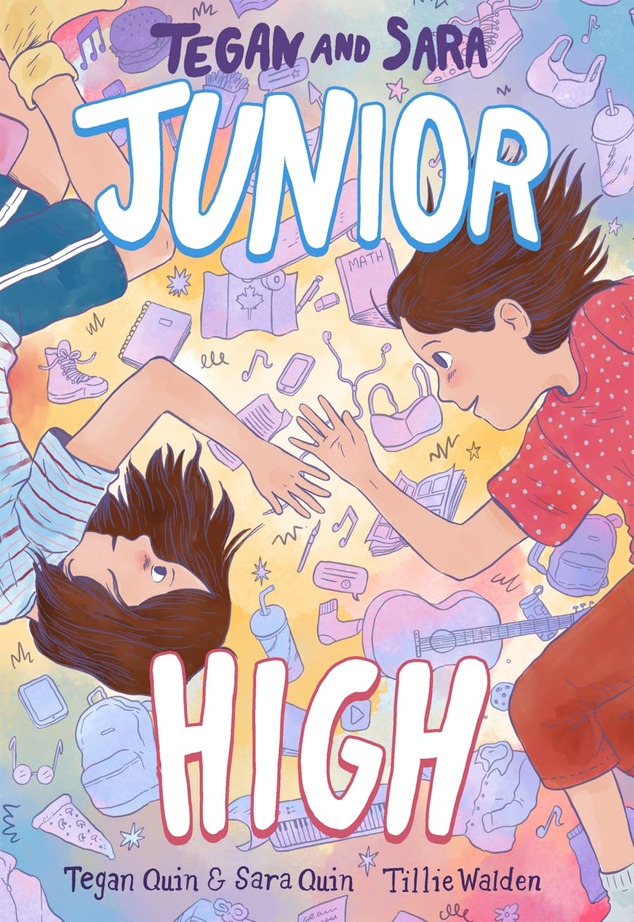
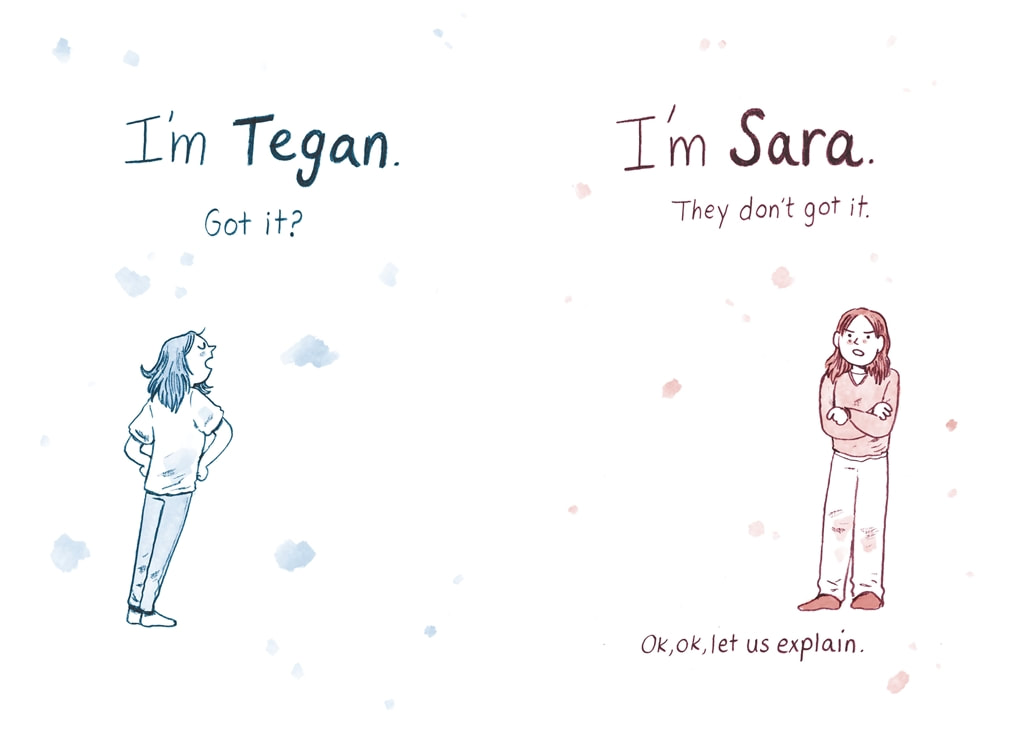
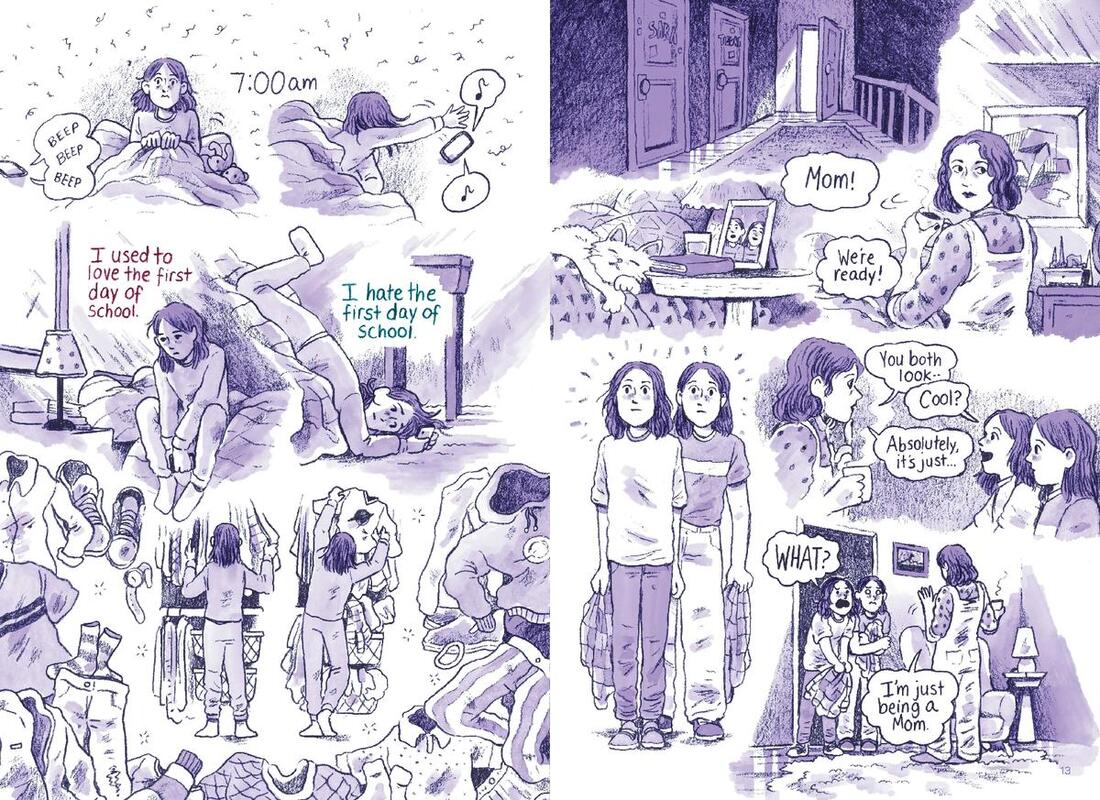
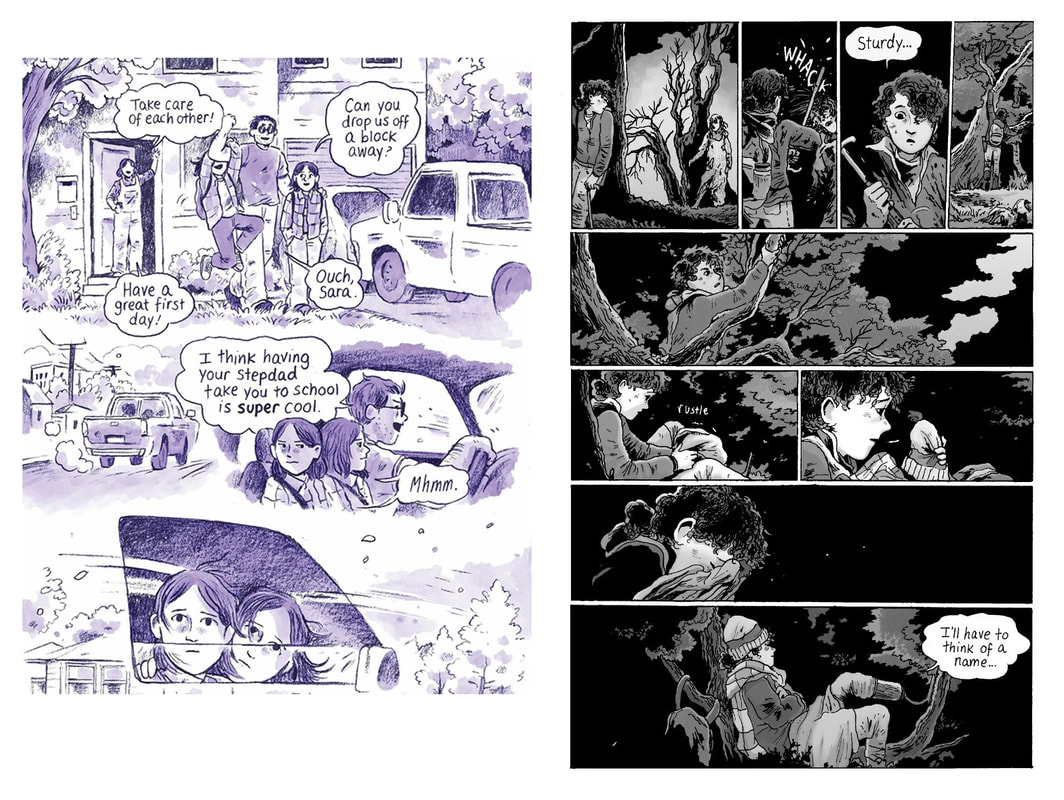
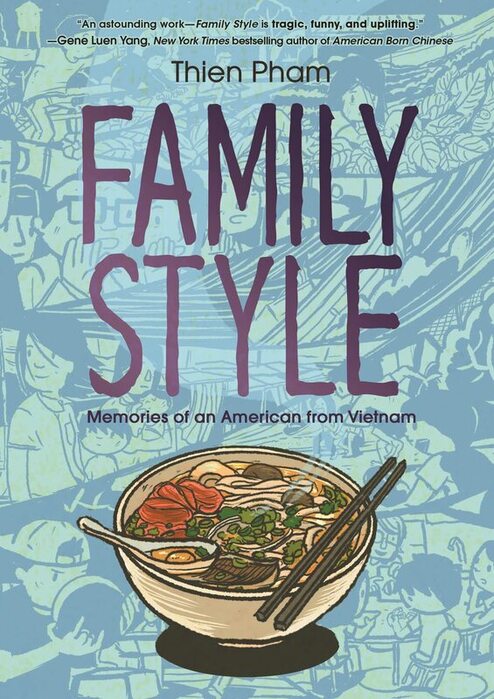
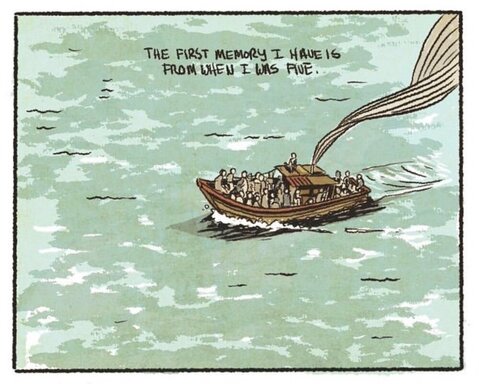
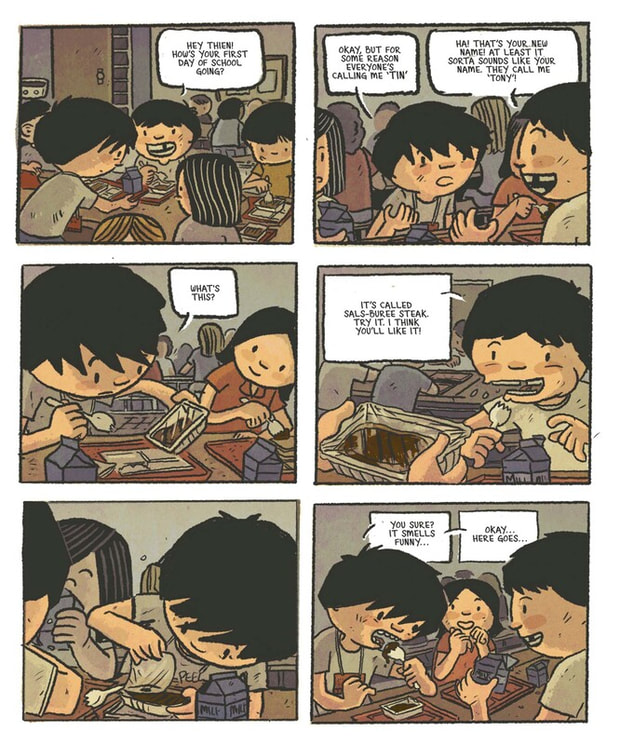
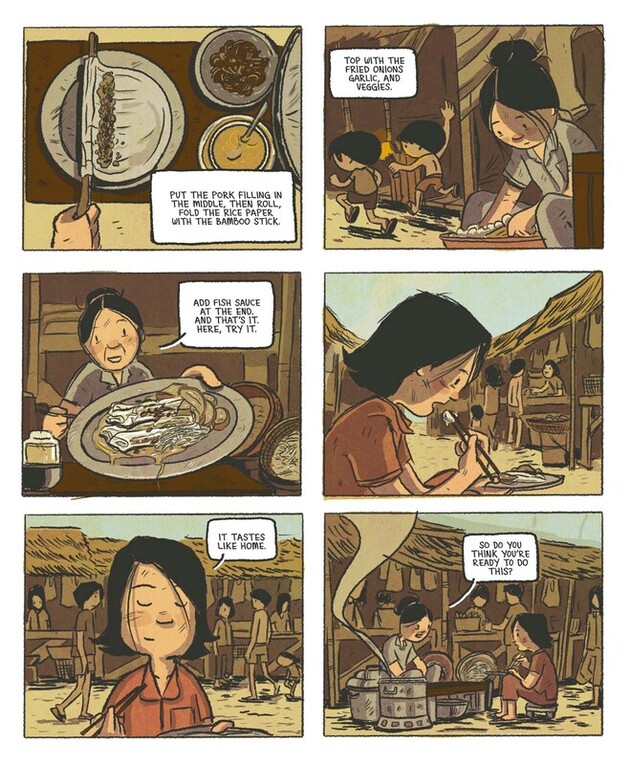
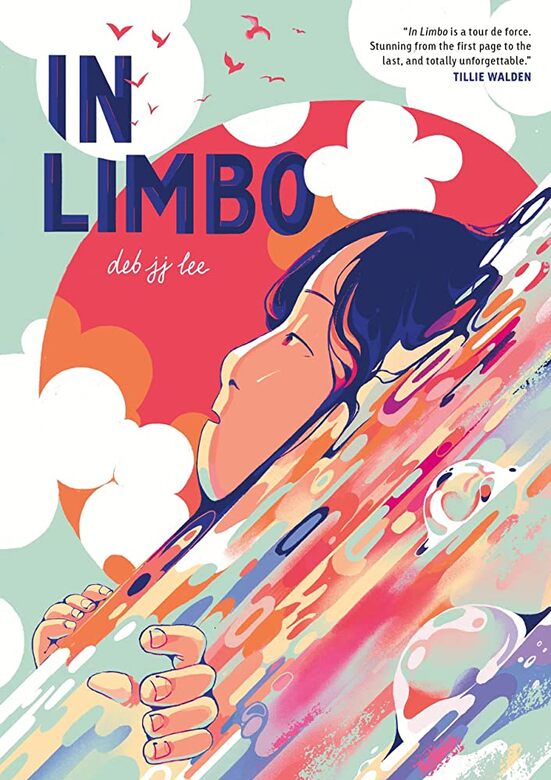
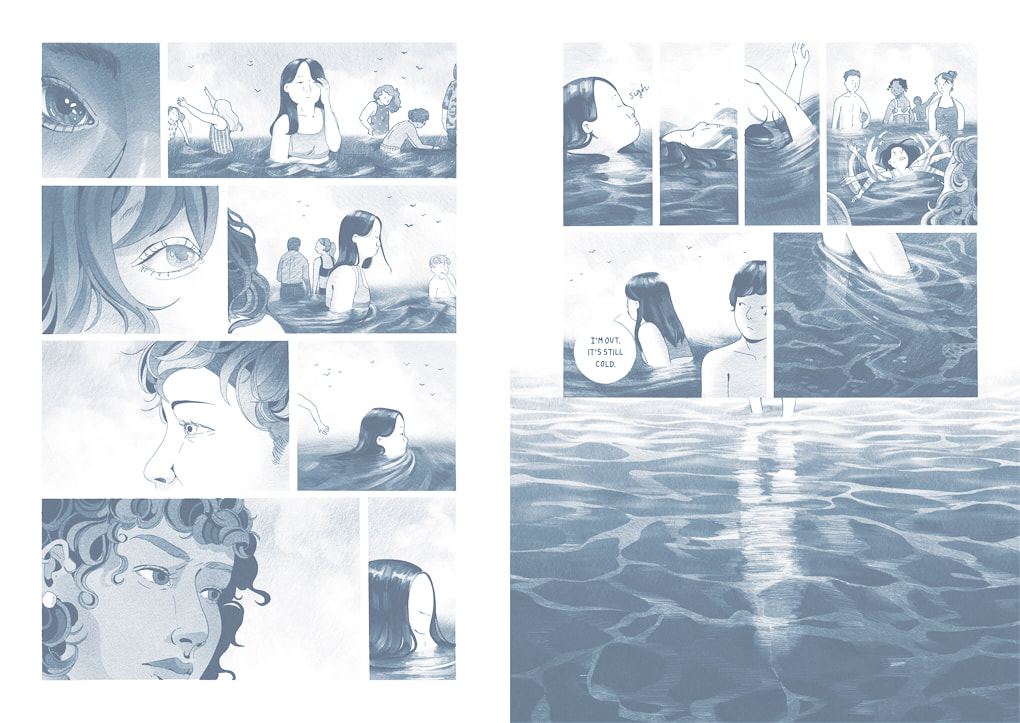
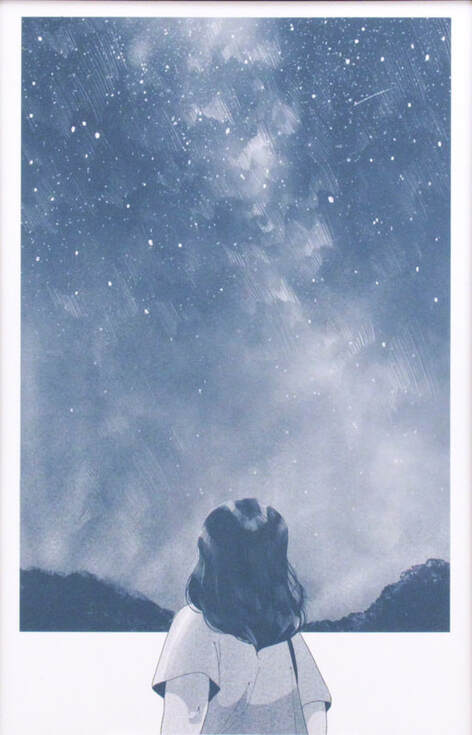
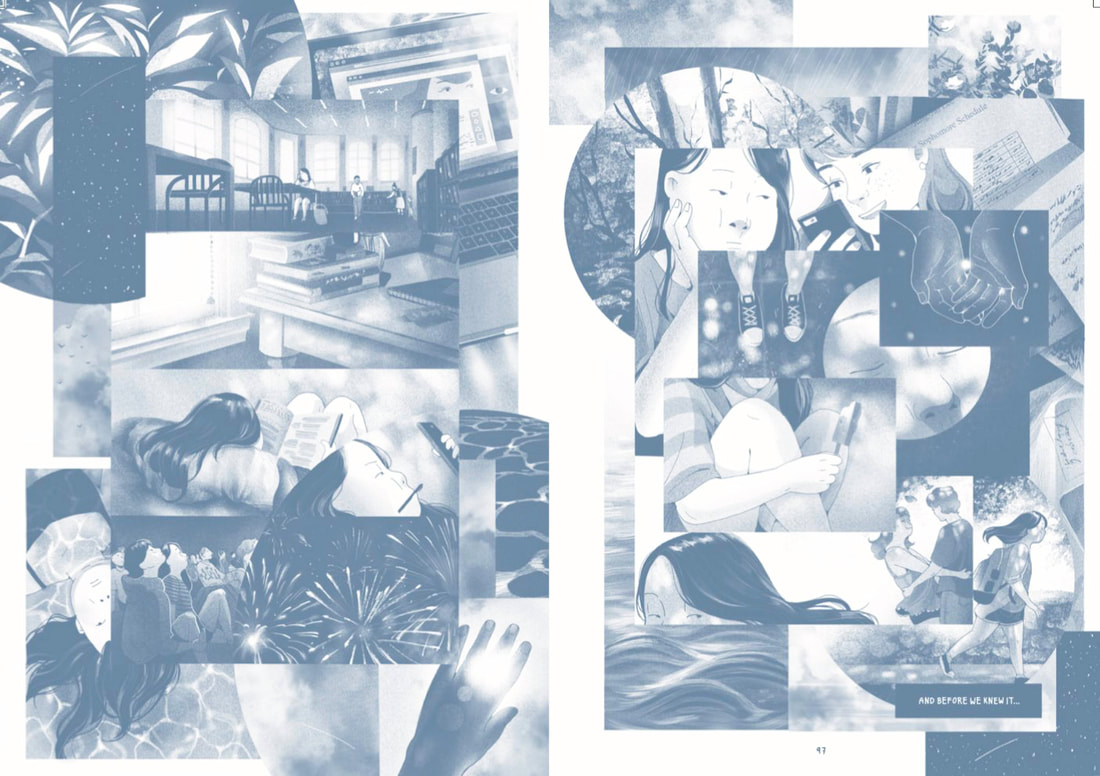
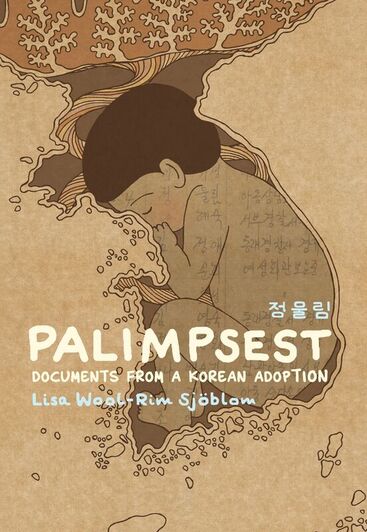
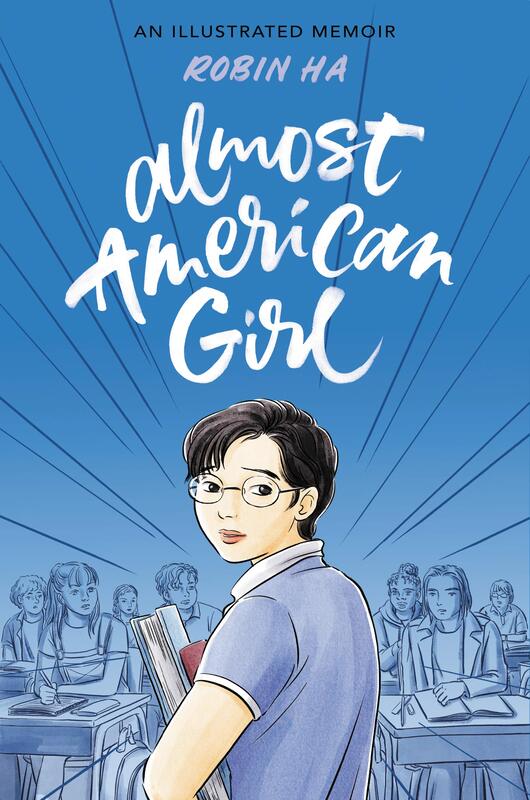
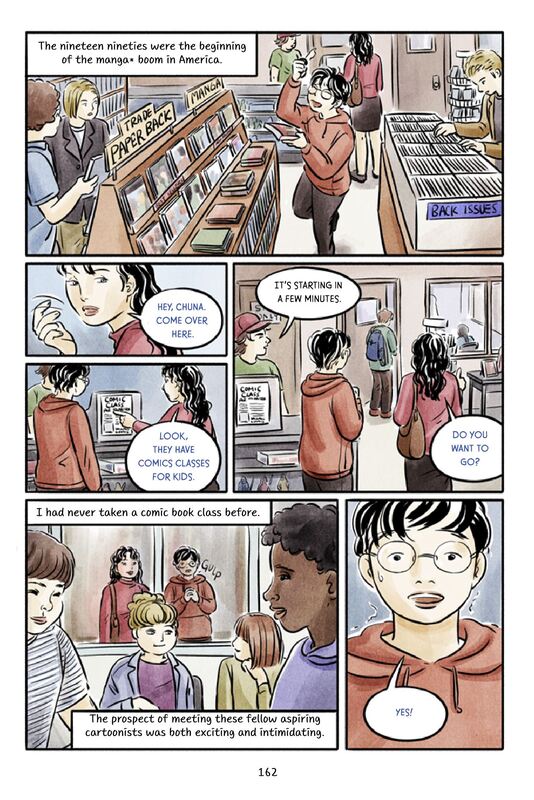
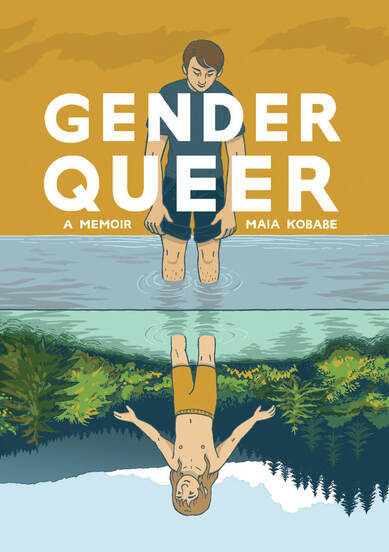
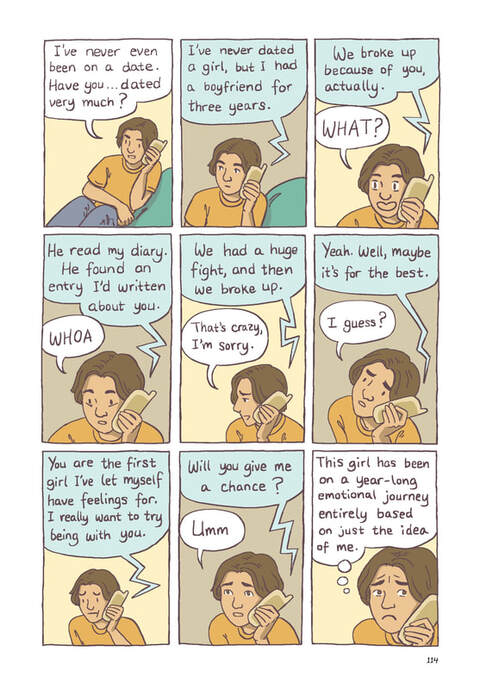
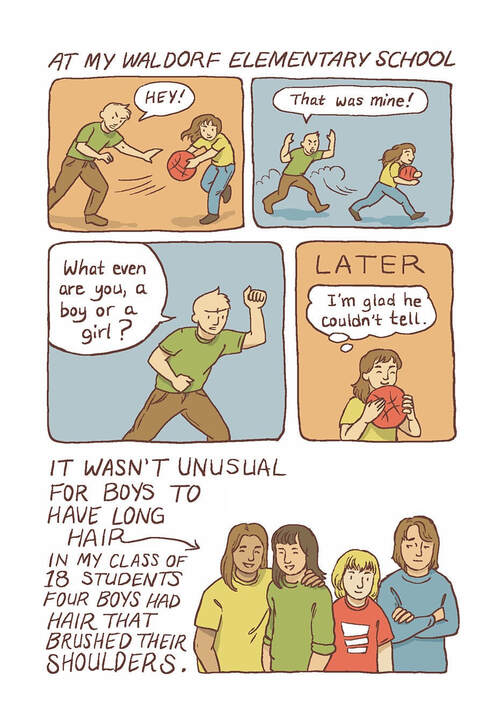
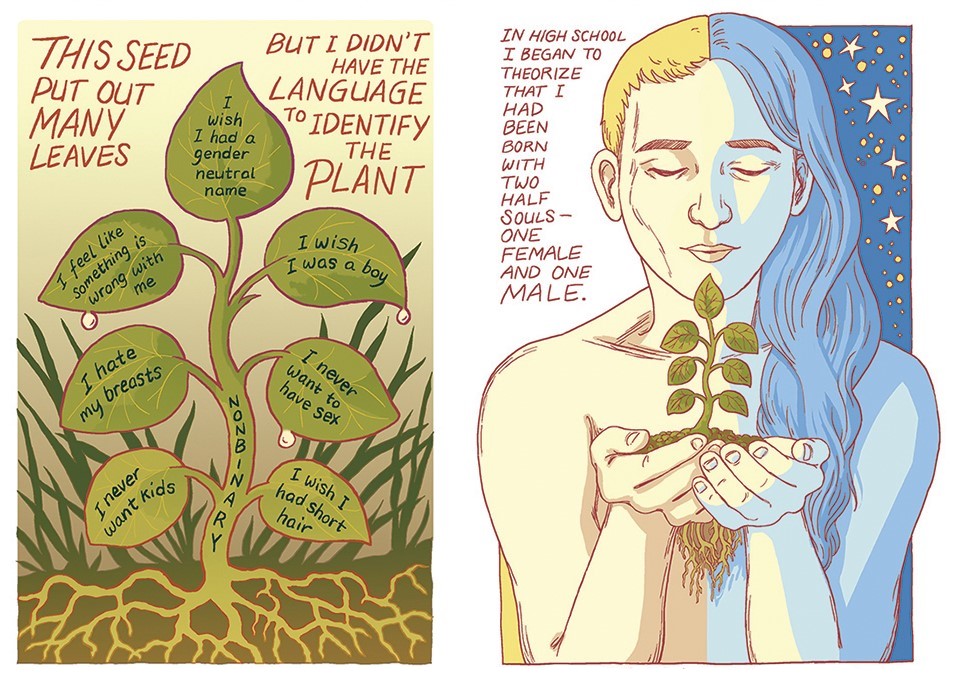
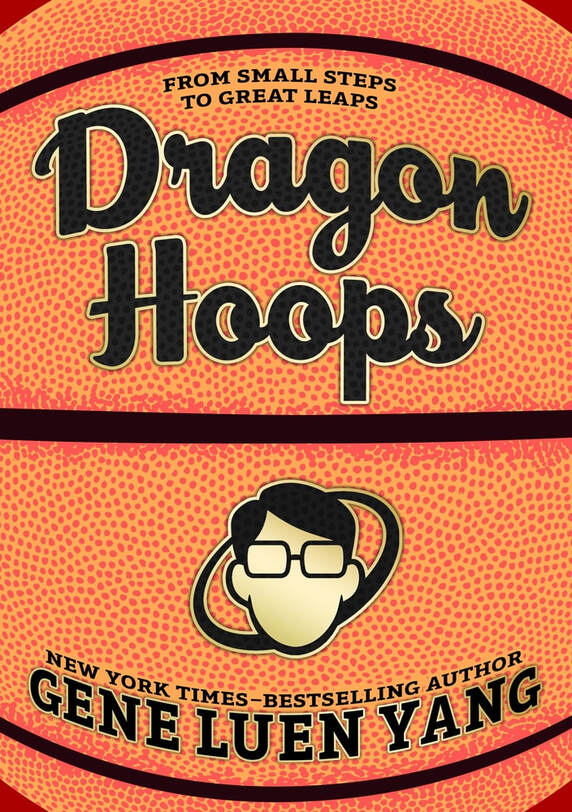
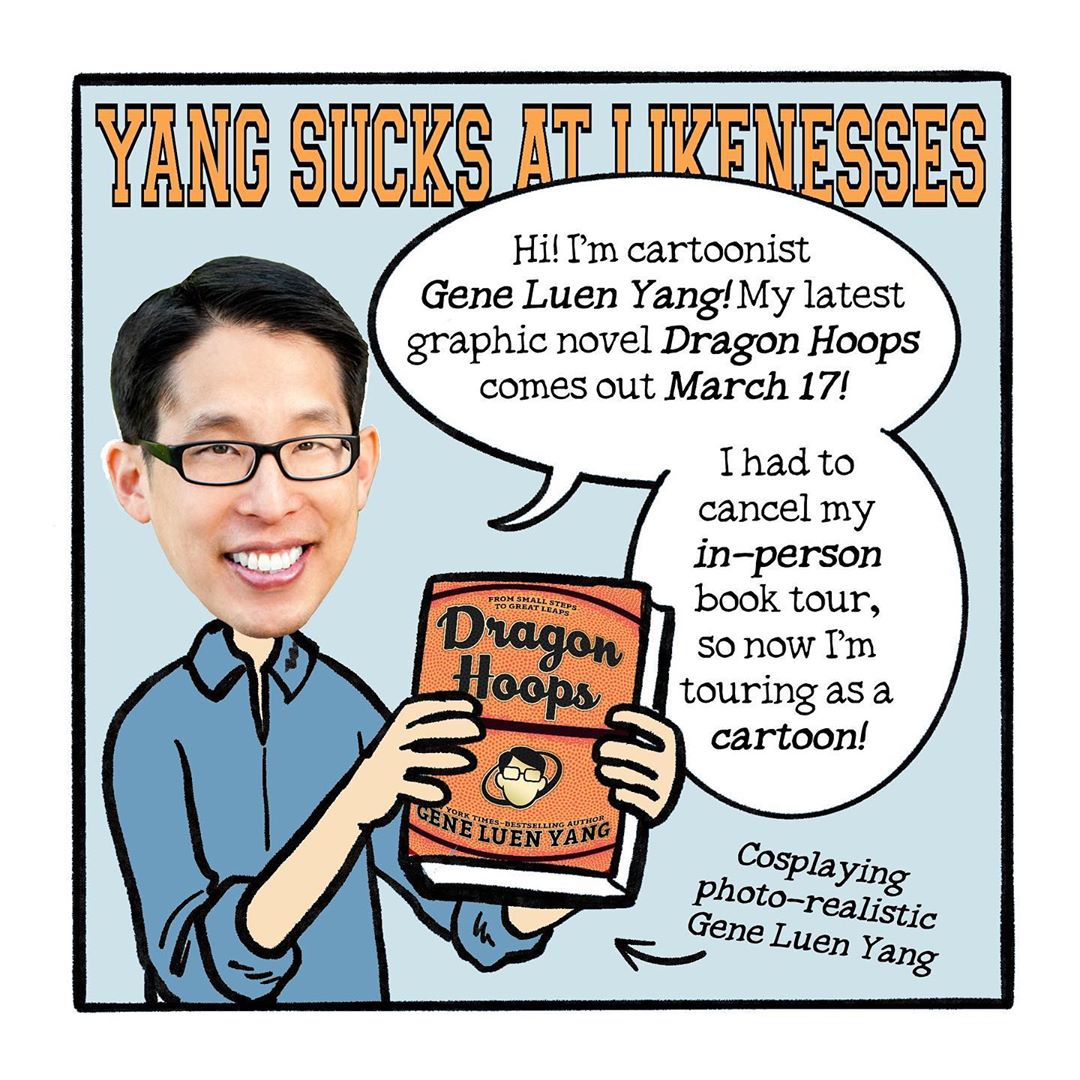
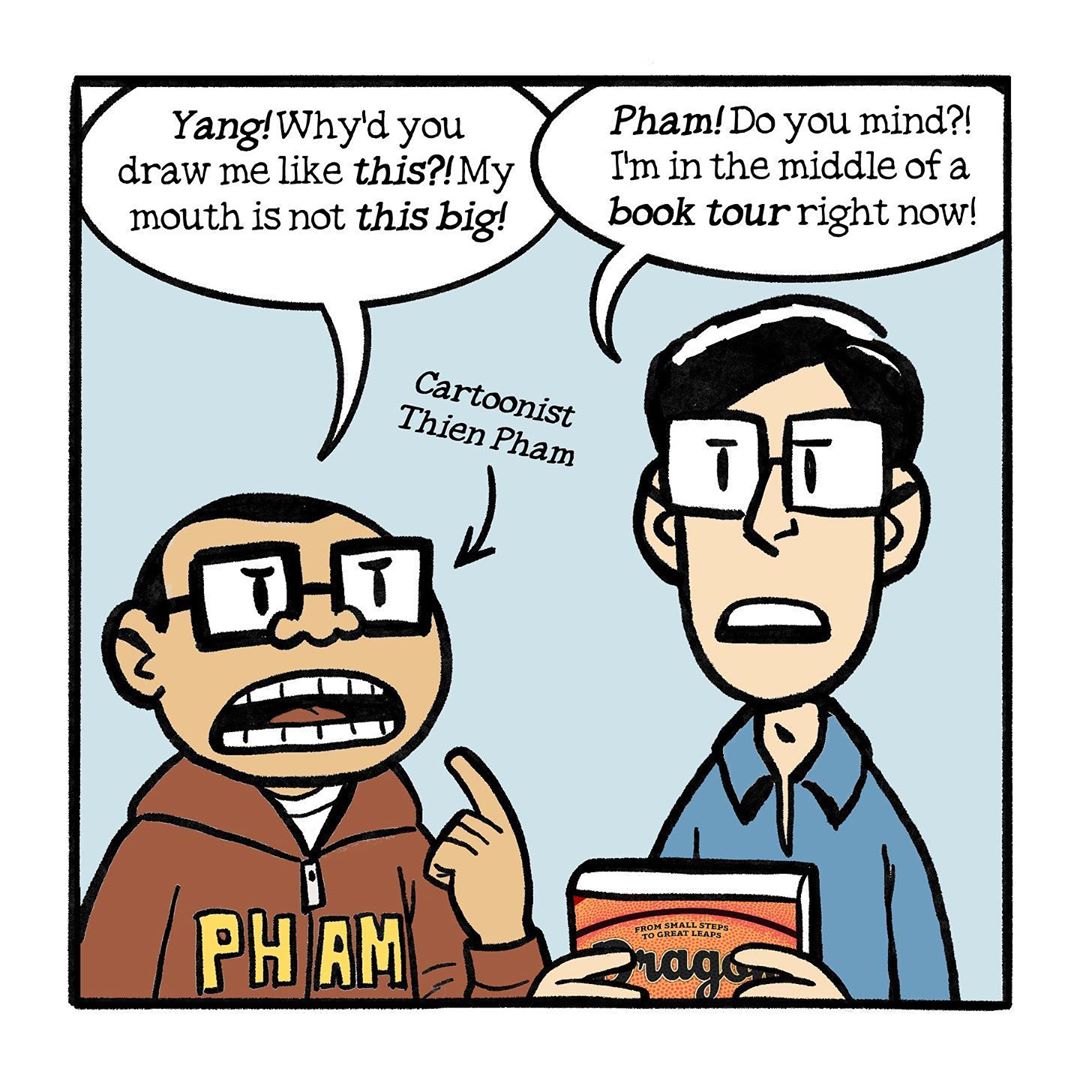
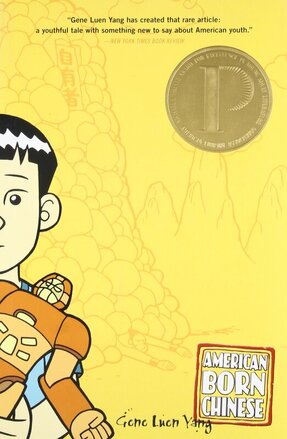
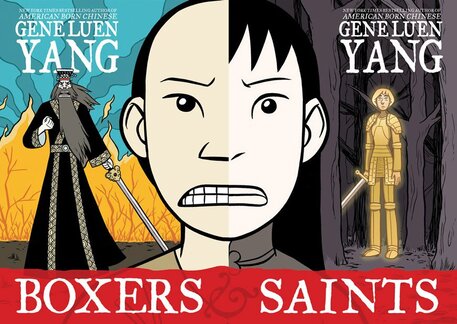
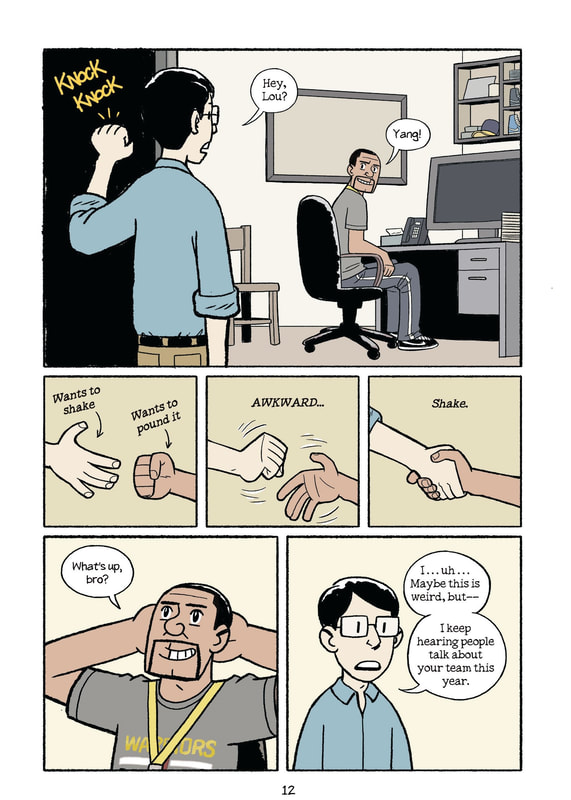
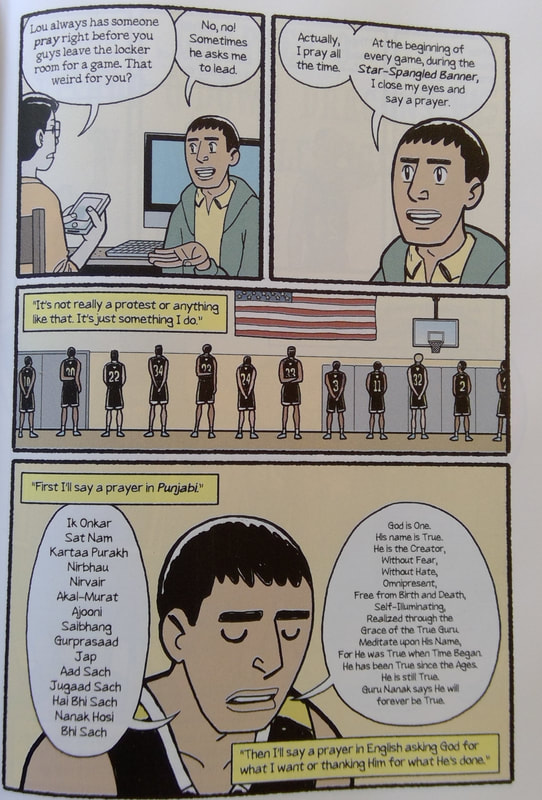
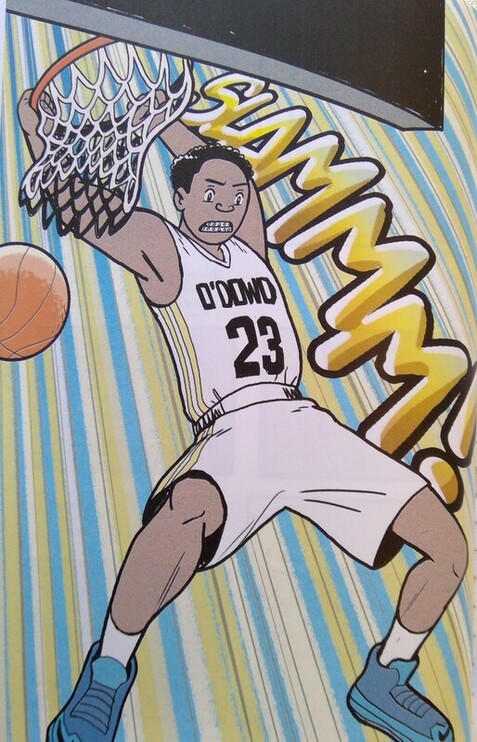
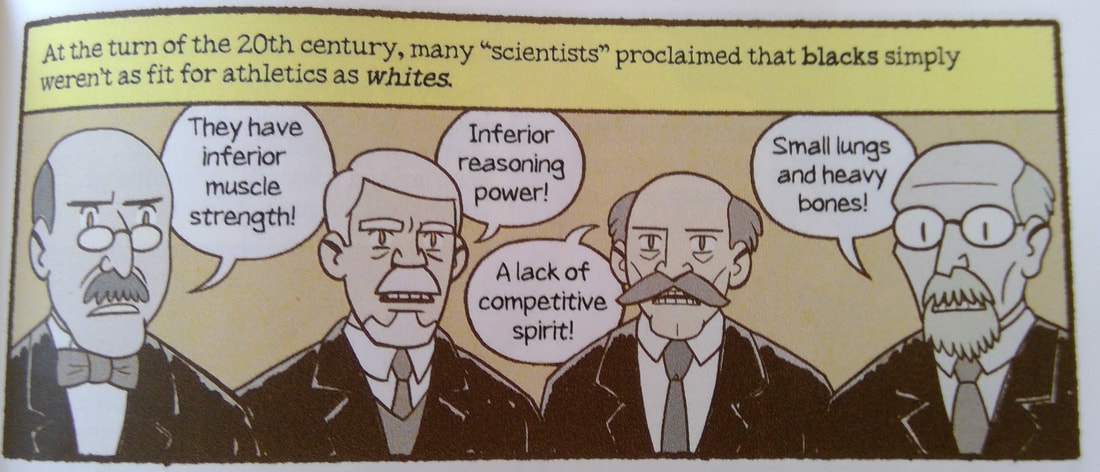
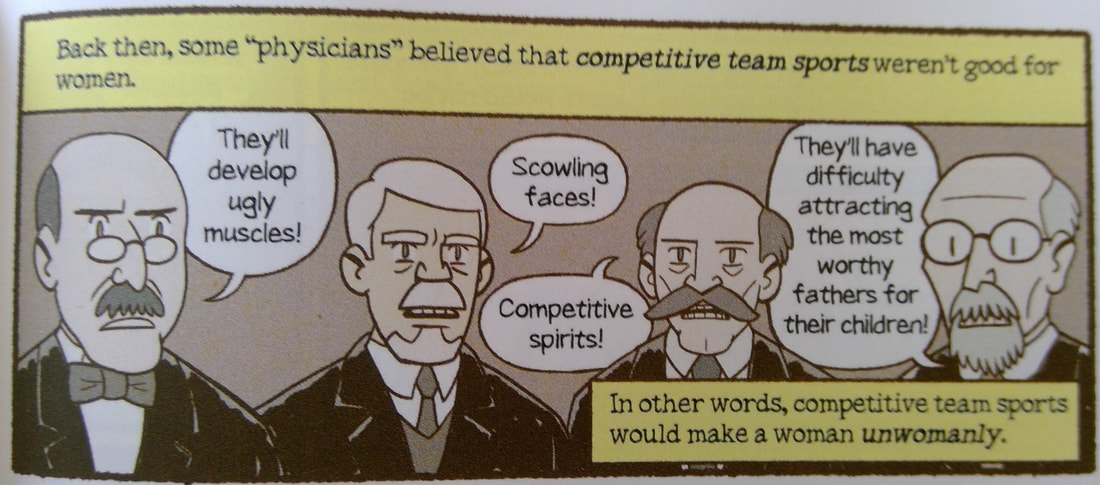
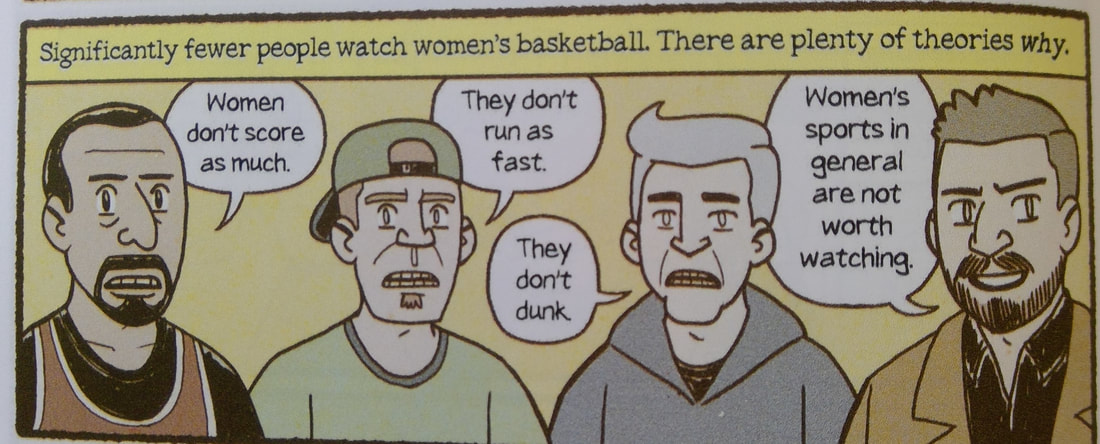
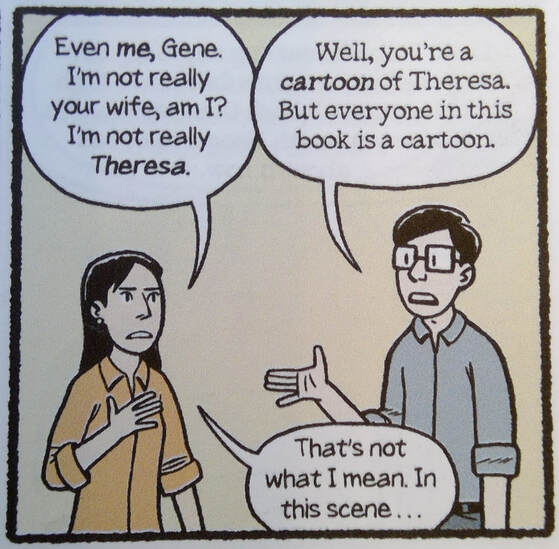
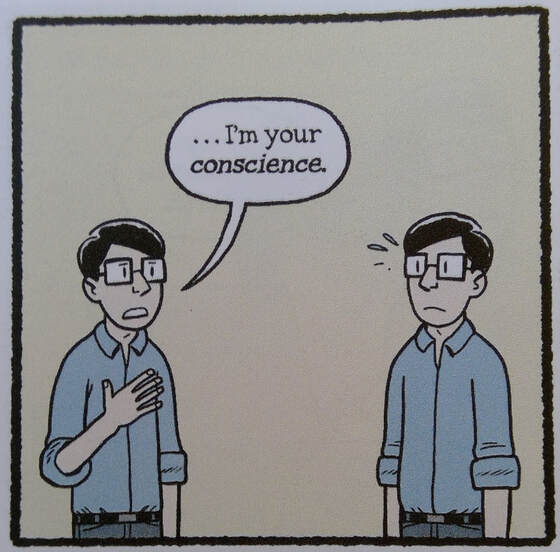
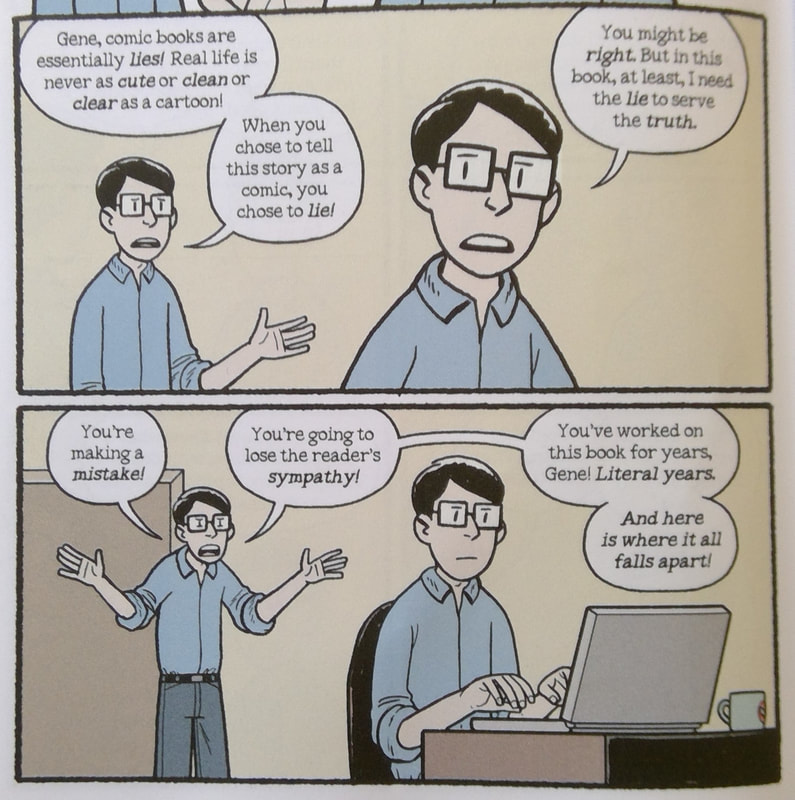
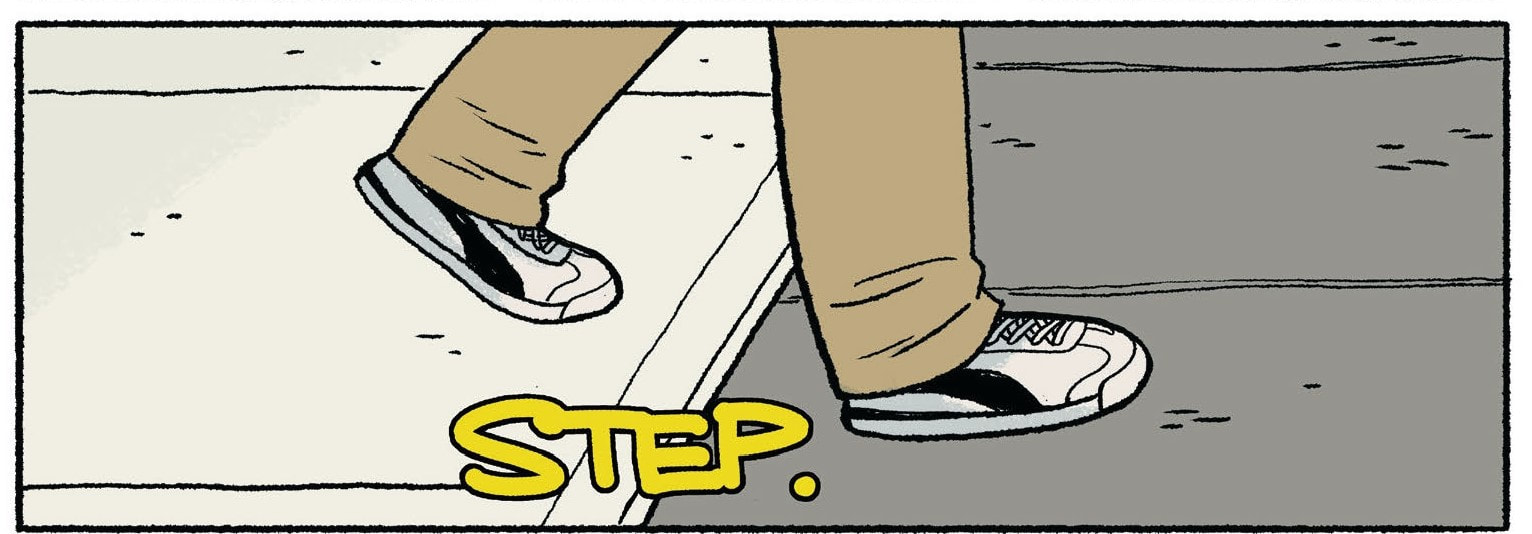
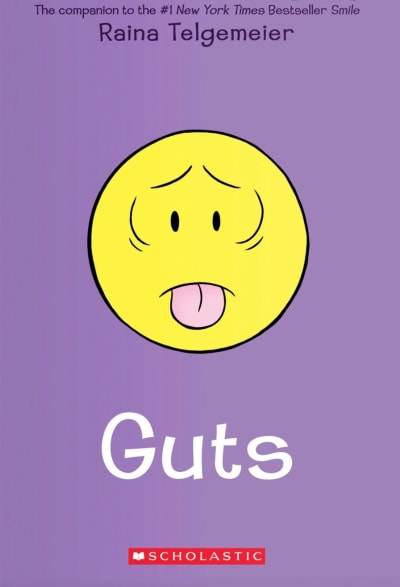
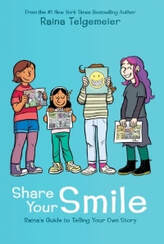
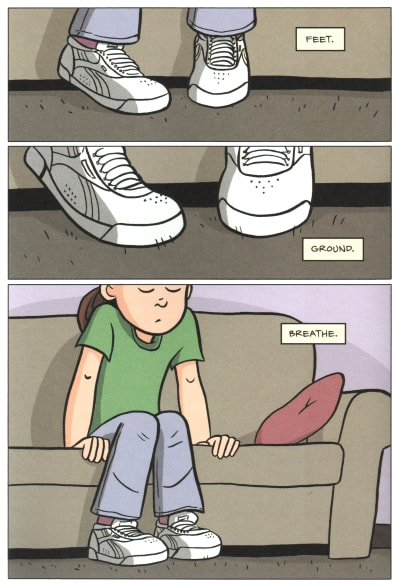
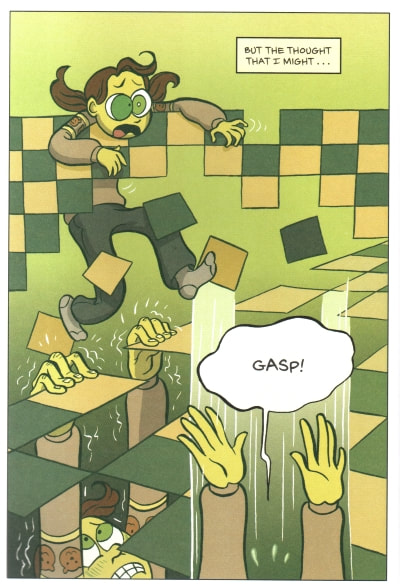
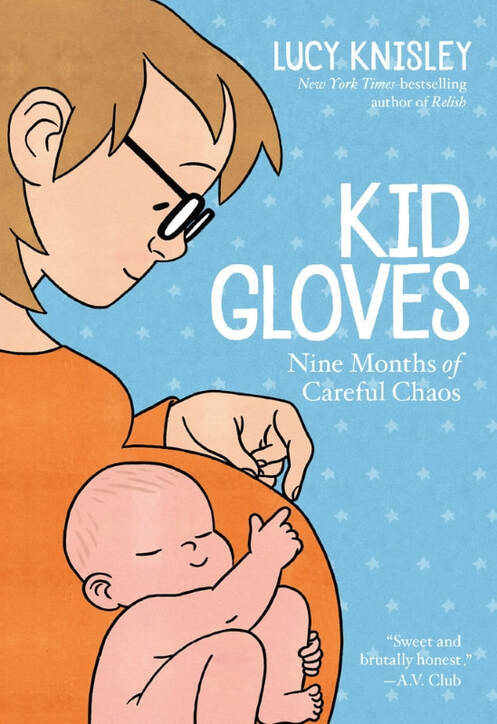
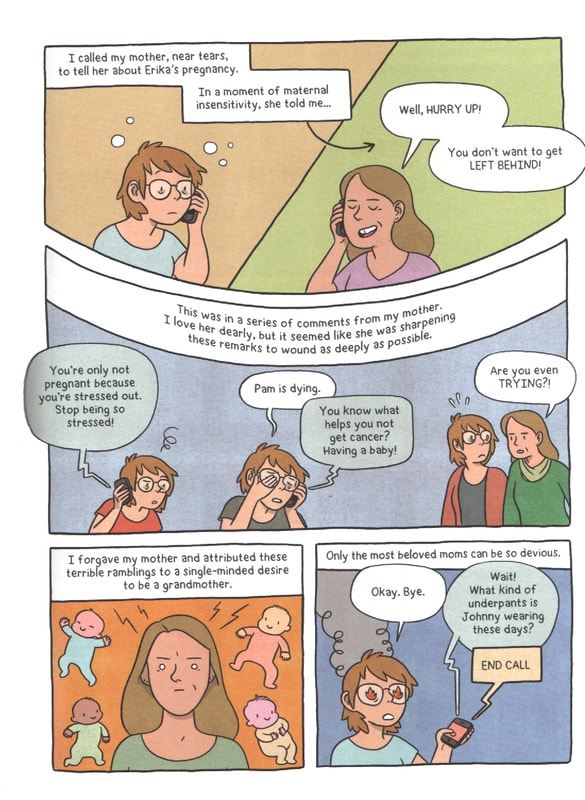
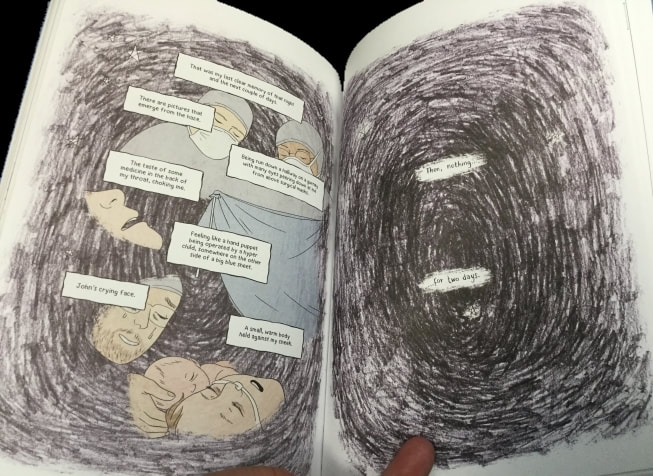
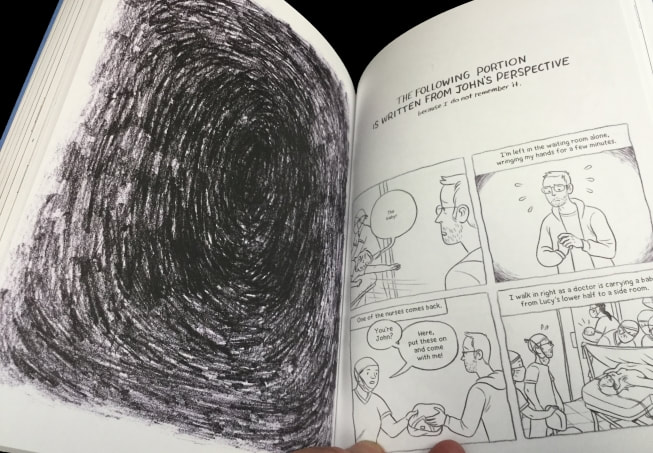
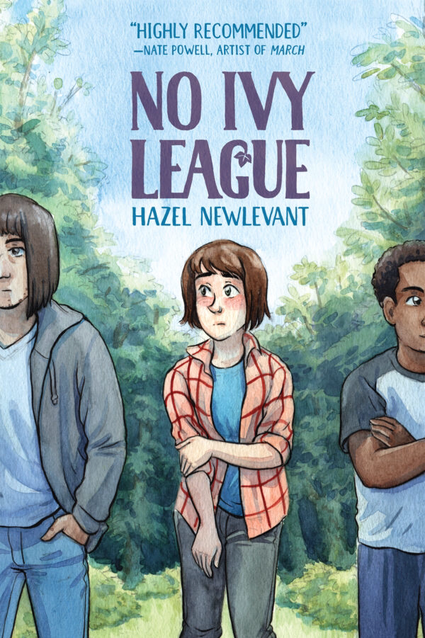
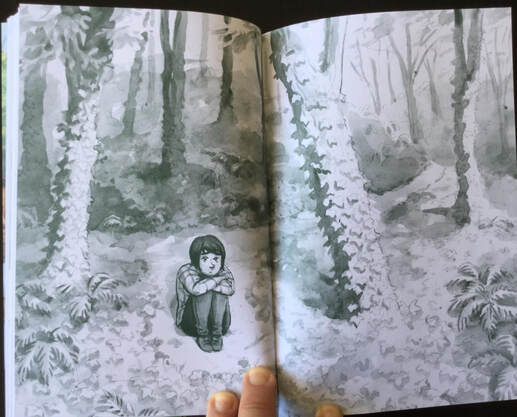
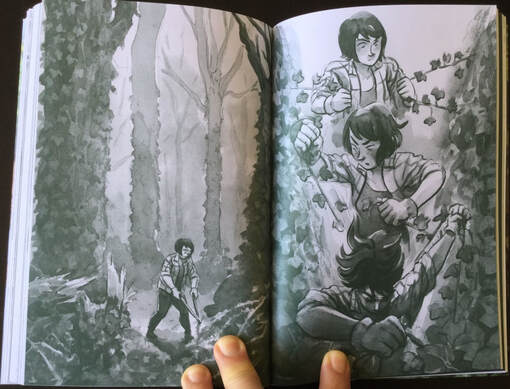
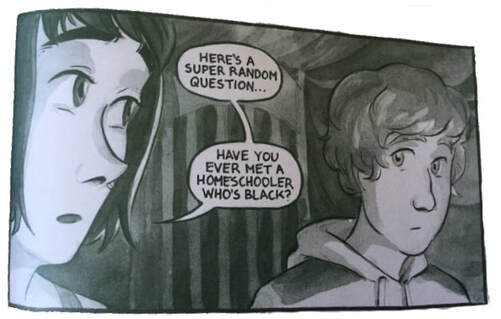
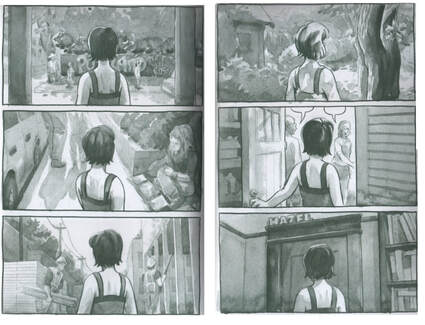
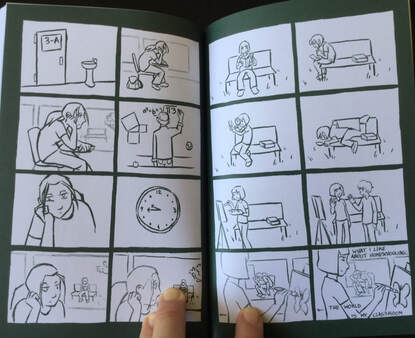
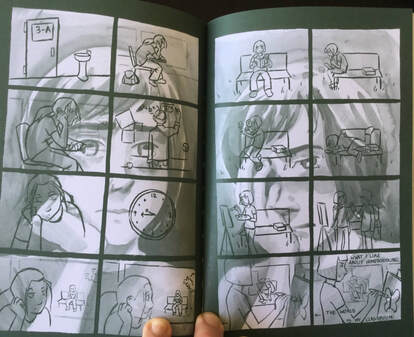
 RSS Feed
RSS Feed
